Strasbourg, 10 August 2022
T-PVS/Files(2022)40
CONVENTION ON THE CONSERVATION OF EUROPEAN WILDLIFE AND NATURAL HABITATS

Standing Committee
42nd meeting Strasbourg, 28 November 2 December 2022 Open File: 2012/9

Strasbourg, 10 August 2022
T-PVS/Files(2022)40

Standing Committee
42nd meeting Strasbourg, 28 November 2 December 2022 Open File: 2012/9
Document prepared by MEDASSET
Document
by MEDASSET the Mediterranean Association to Save the Sea Turtles
for the 42nd Standing Committee Meeting of the Contracting Parties to the Convention on the Conservation of European Wildlife and Natural Habitats (Bern Convention)
MEDASSET hereby submits an update report to the second Bureau Meeting of the Bern Convention (September 2022) on the conservation status of sea turtle nesting beaches in Fethiye and Patara Specially ProtectedAreas (SPAs) in Türkiye.
Contents:
ANNEX I: FETHIYE DETAILED UPDATE, BACKGROUND, MAPS & PHOTOGRAPHS
ANNEX II: PATARADETAILED UPDATE, BACKGROUND, MAPS & PHOTOGRAPHS
ANNEX III: REFERENCES
Production and dissemination in full or in part of this publication for non commercial purposes are authorised without any prior written permission provided the source is fully acknowledged and cited.
MEDASSET visited Patara and Fethiye SPA in July 2022 to assess and document the conservation status of the nesting beaches. The following presents the survey findings in relation to each of the measures under Recommendation No. 183 and 182 (2015).
The loggerhead sea turtle (Caretta caretta) nesting beaches in Fethiye (Muğla Province, Türkiye) are among the 12 most important nesting beaches in Türkiye1.The nesting beaches belong to the Fethiye Göcek Special Environmental ProtectionArea (SPA) established in 1988. Scientific studies have shown that nest numbers in Fethiye are declining2
As we reported in 2021, the habitat destruction due to the new hotels, which were constructed directly on orbehind the nesting beaches, and expanded onto the nesting zone, reduced the available habitat and increased disturbances.New developmentswere also observedin2022.Renovationsinthe promenadearea continued, and a new pedestrian path is lining the seaside. In Yanıklar, a large enclosed construction area was observed behind Deniz İncisi. Villas are still under construction behind Hotel Liberty Fabay. Further developments took place in the picnic area at Akmaz Beach and further south in the section, Lykia Botanika was reopened and enlarged (Rec.Point 1).
1 Türkozan 2000; Margaritoulis et al. 2003; Canbolat 2004
2 Ilgaz et al. 2007; Katilmis et al. 2013; Başkale et al. 2016
During our 2022 assessment we observed certain improvements in the management and enforcement of regulations. However, many serious problems remain, imposing serious threats to the sea turtles, necessitating immediate actions for further improvements and corrections: There were new wooden posts installed, marking the nesting zone border in large sections of the SPA, but in many areas the zoning was incorrect and nests were behind the posts. Most facilities moved their bars, platforms, wooden paths, showers, pavilions, sunbeds and umbrellas behind these zoning posts. (Rec Points 2, 5). While the beach was cleaner (Rec. Point 12) and beach furniture in front of most facilities were behind the posts marking the nesting zone during the day, there remain issues with camping, bonfires, planting on the nestingbeaches, severelightpollution,lackofvehicleaccess control,andhumanpresenceatnight(Rec.Points 2, 4 8, 11, 15). During our assessment, we did not observe guards or controls in the protected area (Rec. Points 13, 14). Nest monitoring and awareness activities by research institutions continues and the SPAseemed to be monitored more efficiently (Rec. Point 10, 16).
Seven years since the adoption of Recommendation No. 183 (2015), the nesting beaches in Fethiye Specially Protected Area (SPA) require further protection efforts and implementation of the measures under Recommendation No. 183. It is a problematic “protected” area based on its partial implementation of the measures and the destructive development that has been permitted to occur over the past years in complete disregard of the Bern Convention’s Recommendation.
In 2022, the main unresolved conservation problems that are negatively affecting the nesting beaches remain. As a result, Patara nesting beach does not receive the appropriate protection and management, based on what we observed. For example, there is still no confirmation of the SPA borders and while there is a new legislation prohibiting entrance to the beach from 20:00 to sunrise (Rec. Point 1) it was not enforced, as most checkpointswere not manned andthere werenopatrolson thebeach(Rec. Point 3).Therewasalsoinsufficient nest monitoring and protection from trampling or predation due to lack of resources (Rec. Point 4, 7, 8). There is no zoning in the North beach and no consideration of the topography and characteristics of the beach resulting in problematic zoning in the South beach (Rec. Point 9). We observed 4x4 quad riding and camping (Rec.Points 2).Therewaspoorbeachfurnituremanagement at theSPA’ssinglebeachfacility,whichislocated within the nesting hotspot (Rec. Point 2). There was direct light pollution and skyglow pollution from the summer house village (Rec. Point 2).
Construction of the 300+ summer house development in the 3rd Degree Archaeological site of the SPA, in close proximity to the dunes and the nesting beach is largely completed (Rec. Point 4). Once populated, the summer population will increase by at least 120% (current population during the summer being ca. 1000). It is evident that the conservation problems presently occurring will increase likewise. In addition, redetermination of Patara SPA’s borders and zoning is ongoing (Rec. Point 1), and, as no final maps are available online, it is unclear if the entire nesting beach (north and south section), the nearshore marine areas and the entire sand dune areas are appropriately zoned and protected against any further development.
To date, Recommendation No. 182 (2015) has not been fully implemented. Patara’s nesting beaches have not been totally safeguarded against development to date.As we have previously indicated, improvements in the management and control for effective implementation of the Recommendation, will allow this unique natural and heritage site to become a showcase example, similar to the much renowned nearby Dalyan SPA (İztuzu beach). It is of high priority for authorities to take action and resolve the remaining unresolved conservation and management problems with no further delay, in light of the renewed interest in the SPA’s archaeological site.
MEDASSET calls upon the Turkish authorities to:
Urgently implement Recommendations No. 182 & 183 (2015) through a comprehensive and updated action plan as soon as possible to implement all measures.
Produce SPA management plans for both sites that include zoning and that cover both the land and marine areas, including clear descriptions of permitted land uses and activities. The current law (Circular) provides general guidelines, but a management plan for each SPA is necessary to specify and localise these regulations.
In relation to Fethiye, provide an official map of the beach and adjacent land area that are under dispute, and of the areas that have been permitted for development. As per Measure 1 of the Recommendation, declare a building moratorium to prevent any further development (hotels, jetties, etc.) on or directly behind the nesting beaches and correct the zoning errors.
Provide the necessary resources for the effective protection of the beach (guards, vehicle barriers etc.).
In relation to Patara, provide an update on the ongoing redetermination of Patara SPA’s zoning and ensure that the entire nesting beach (north and south sections), the nearshore areas and the entire sand dune areas are appropriately zoned and protected against any further development.
Address the concerns raised in MEDASSET’s complaint regarding the Patara now largely completed summer house construction project, its scale, the associated impacts, the lack of an EIA and of a carrying capacity study. Provide detailed information on the additional houses constructed outside the summer house construction project.
MEDASSET calls upon the Bern Convention Standing Committee to:
Discuss the case file at the 42nd Meeting of the Standing Committee.
Keep the case file open for further monitoring.
Urge Turkish authorities to implement Recommendations No. 182 & 183 (2015) as soon as possible.
RequestTurkish authorities to produce the necessary plan and provide further information on the case, as requested in the abovementioned points.
Nesting beach description (Fig.1): The 8 km beach is split in three sections: Çalış, Yanıklar, and Akgöl. Çalış is 2.5 km long and divided into two sections: Çalış B (Koca Çalış northern part) and Çalış A (Küçük Çalış southern part), which is the section that is bordered by a wall and a promenade lined by tourist infrastructures. Çalış Hill marks the end of Çalış and the start of Yanıklar, which extends northward for 4.5 km and includes the so called “small beach” and Karataş beach. Kargı stream marks the border between Yanıklar and Akgöl (1 km, also known as Karaot beach). For a detailed description of the Fethiye SPA nesting beaches see MEDASSET 2009.
MEDASSET visited Fethiye SPA in July 2022 to assess and document the management and conservation status of the nesting beaches. The following presents the survey findings in relation to each of the measures under Recommendation No. 182 (2015).
1. Stop any further development of permanent structures (buildings, roads, shipyard, jetties/docks, etc.) along the entire coast of the nesting site complex, in order not to reduce further the nesting habitat;
Renovations in the promenade area have finished (Fig.2a b), creating a broad walking space with a wall slightly higher than before, lining the seaside. Orange pinkish lights are embedded along the wall, facing the walking area. Tall lamp posts additionally placed along the wall are not facing the beach, although they are bright white(Fig.3a b). These are new permanent structures in Çalış A and B.The caravan area used byZirkon Camping did not have any permanent structures (Fig.4).
In Yanıklar, a new large enclosed construction area was observed behind Deniz İncisi, with construction work ongoing at the back (Fig.5a c). Fabay Villas (Fabay Kızılada Apart Houses) are still under construction behind Hotel Liberty Fabay, away from the beach (Fig.6). At the picnic area right past the hotels (Akmaz Beach), a new facility called “Akmaz Doğa Mesire Yeri (Akmaz Natural Recreation Area)” is established (Fig.7a e).ThepublicfacilityisrunbyFethiyeForestryDepartment,opentovisitorsbetween08.00and20.00. The last visitors were seen leaving around 21.00, right after sunset. Signs were placed to prohibit camping, putting up tents, barbecuing, and building fires, although none mention sea turtles (Fig.8). A path has been paved leadingto it, passingadjacent to Hotel TUIBLUE Sensatori Barut’s border.Further southin thesection, Lykia Botanika Hotel was reopened and enlarged (Fig.9a c).
In Akgöl, former Karaot Buffet reopened with the name “Hayal Café” (Fig.10a c).
2. Remove any structure (wooden paths, wooden pavilions, bars, platforms, showers, carpets, patios, etc.) from sand zones, including those to be restored, especially in areas with relatively narrow beach width and/or in tracts with narrow sandy strips; and restore the sandy areas;
5. Map the whole Fethiye coast using long term data, maps and imagery to identify the past, current and potential most suitable zones for sea turtle nesting, and set a maximum percentage limit of sandy tracts where touristic structures are allowed on the nesting beach and define (A) coastal tracts less suitable for turtle nesting, where beach furniture is allowed at appropriate densities and (B) coastal tracts adequate for turtle nesting, where beach furniture and access at night are not allowed. Enforce beach furniture removal/stacking at night along the entire nesting beach complex during the nesting/hatching season;
We hereby report on both of the above measures jointly (No.2 and No.5), as in 2021, in order to better reflect the updated situation of nesting beaches after new arrangements in 2022.
As per the project titled “Determining the Sea Turtle Nesting Areas and Demarcation of Their Borders” carried out by the Directorate General for Preservation of Natural Heritage under Turkish Ministry of
Environment and Urbanization in 5 SPA’s3, the Fethiye SPA was fitted with new wooden posts marking the nesting zone border, with the exception of the promenade area in Çalış A and the pristine section in Yanıklar Beach. However, the actual nesting zone in some areas visibly extends beyond the posts and nests were seen behind them. The most striking examples of incorrect zoning were in front of the Municipality’s facility in Akgöl, Okaliptus and Katrancı Beach in Yanıklar, Onur and Lotus Beach in Çalış B. Wooden posts in some parts of Çalış B, in particular, are only a few metres away from the sea, purposely leaving sandy areas suitable for nesting to be used for placing beach equipment.
To summarize, implementation of Measure No. 5 finally began and around 40% of the beach in the entire SPA is now reserved for sea turtle nesting. However, there are extremely sensitive nesting grounds excluded from zoning and zoning is erroneous in many sections. Most facilities moved their bars, platforms, wooden paths, showers, pavilions, sunbeds and umbrellas behind these zoning posts. Beach furniture in front of most facilities were outside of the nesting zone. However, the extremely important removal of cushions and AstroTurf carpets from the designated nesting zones are still pending.
In Çalış A, zoning posts were only used in limited parts at the beginning and end of the section, and nests were seen behind them (Fig.2a, Fig.11a c). The sunbeds were placed in a single row on mid beach (Fig.2a, Fig.12a b). Sundia Liberty and Güneş Hotel were the only two facilities keeping two rows of sunbeds on the beach (Fig.13a d). At night, most sunbeds were stacked and moved towards the wall (Fig.3b, Fig.14). Umbrellas in the entire section were fixed in the sand. Next to all the stairs leading to the beach, black hoses were seen extending (Fig13a). Although their purpose is unclear, they may be draining onto the nesting beach. Shower cabins placed near the stairs also drain directly onto the beach, with their undersides used as bins (Fig.13a, Fig.15).
In Çalış B, the distance of zoningpoststo the seachanged fromabout 10metres inthe south part (Fig.16a b) to 5 metres in the north part (Fig.17a b), and beach equipment was kept behind these posts in the majority of the section. In a few locations, some nest cages were seen behind the zoning posts. A caged nest near Lotus Beach was especially far behind the posts, almost double the distance of posts to the sea (Fig.18a). Although beach equipment was moved to the back of zoning posts, the wedding altar in Lotus Beach still stands right behindthe nesting beach (Fig.18b c). Most facilities had around 20 30 sunbeds, while a few larger ones (Resul Bali Sultan, Odyssey, Celina, Leon) had around 100 150 sunbeds. Yücel Beach had four rows of sunbeds behind the zoning posts, with vertical and horizontal walkways in between, carpets placed on the walkways, cushions randomly thrown around, and pavilions (Fig.19a b). Surf Station/Mavi Beach, Surf Beach, Jiva and Celina kept water sports equipment on the nesting beach, close to the waterline, and did not remove the laid AstroTurf (Fig.17a, Fig.20a d). Sunbeds at Surf Beach were not organized and some were very close to the sea. Additionally, boats were observed on the beach in a few areas (Fig.Fig.21). Leon beach had a volleyball court next to sunbeds, completely surrounded by a mesh, and a nest cage was seen near it (Fig.22a d). Next to it, Apache Beach drew attention as they did not comply with the new arrangements, leaving sunbeds and other equipment scattered on the nesting beach (Fig.23a b). There were also wooden stakes erected in the sand in front of the facility, the purpose of which remains unclear at this time (Fig.24). Butik Camping/My Beach had showers on the beach, which directly drain on the sand (Fig.25). All umbrellas in this section were fixed in the sand.
In Yanıklar, Karataş Beach is fully occupied with four rows of sunbeds, with vertical walkways in between, leaving virtually no space for sea turtle nesting (Fig.26a b). Sunbeds of Deniz İncisi (max 30) were placed in a single row behind the zoning posts, with fixed umbrellas in the sand (Fig.27a b). However, some people had inserted their personal umbrellas randomly into the sand within the nesting zone (Fig.27a, Fig.28). Liberty Fabay had about 20 pavilions, all behind the zoning posts located at least 30 metres away from the waterline, and the only structure within the nesting zone was a lifeguard tower (Fig.29a c). Between the two hotels, a water sports area keeps a very high number of sea vehicles including kayaks and speed boats on the nesting beach (Fig.30a c). There is also a ramp and a quay right next to it (Fig.31a b). Right next to the quay, Hotel TUI BLUE Sensatori Barut’s lifeguard tower stands very close to the sea (Fig.32a b). Apart from this area, not a single beach equipment was seen on the beach strip in front of the zoning posts. Vertical wooden walkways of Hotel TUI BLUE Sensatori Barut were far enough from the sea, with about 300 sunbeds and
fixed umbrellas behind (Fig.33). Right where the walkwayends, northward, zoningposts alsoend and sunbeds were closer to the sea (Fig.34a b).
At theother sideofthe drainage channel, AkmazNatural Recreation Area placed around 55 sunbedsclose to the sea, with umbrellas inserted into the sand. Classic picnic tables and a lifeguard tower were also observed on the beach (Fig.7a e, Fig.8). No wooden posts were erected at this section, until the end of the pristine area. Doğa Campinghad three rows ofsunbeds, placedunder frames withoutshades,anda volleyball court (Fig.35). Yonca Lodge resembled a crowded small village, with a lot of tents, picnic tables, a volleyball court, and showers very close to the sea, and large holes dug in the sand by children (Fig.36a e). Lykia Botanika placed two rows of sunbeds under permanent long shades overhead instead of umbrellas. Their volleyball court and beach bar, although behind the wooden posts, were still too close to the sea (Fig.9a c). Between Okaliptüs Beach and Club Tuana, there is a water sports area, where all equipment is placed on the nesting beach day and night (Fig.37a b). Random boats on the beach were also observed at this part (Fig.38a b). Katrancı Hotel had a single row of sunbeds behind the zoning posts, with fixed umbrellas, and another row of shaded gazebos at the back (Fig.39). Water from the showers directly drain onto the beach.
In Akgöl, the Municipality’s facility occupies almost the entire nesting zone with its four rows of sunbeds (about 200 total) and umbrellas, lifeguard tower, beach bar, and a volleyball court. Water from toilets and showers drain onto the beach (Fig.40a b). Hayal Café (former Karaot Buffet) had a single row of about 20 sunbeds and fixed umbrellas behind the zoning posts, which extend until the very end of the section (Fig.10a c).
3. Stop sand extraction and ensure the application of deterrent penalties for these illegal activities; No sign of sand extraction was observed during our survey.
4. Remove planted vegetation, acacia in particular, with a view to restore the remaining sandy beach; Planted vegetation in the SPA was not removed.
In Çalış B, acacia trees near Mavi Beach (Fig.17a, Fig.20a), Lotus Beach (Fig.18b c), and Leon Beach (Fig.22a d)remain.YücelBeachplantedbananatreesonthebeach(Fig.19b).ApacheBeachhasacacia,agave, and palm trees on the beach (Fig.24).
In Yanıklar, Karataş Beach and Deniz İncisi still keep the acacia plantations (Fig.5a c, Fig.26a b), and a newly planted oleander was seen on the beach of Deniz İncisi (Fig.28). Hotels keep their artificial plantations of grass, acacia, and palms behind the zoning posts (Fig.29a, 29c, Fig.30c, Fig.33). Almost all camping facilities northward in Akmaz Beach have acacia trees (Fig.36a c, Fig.37a b, Fig.38a b, Fig.39, Fig.40a b). Lykia Botanika had a planted area of grass, palms and acacia on the beach, next to its volleyball court, and they are watering this lawn (Fig.9a c). Katrancı Hotel also had acacia plantations inside the nesting zone.
In Akgöl, acacia plantations were seen in front of Hayal Café (Fig.10c).
6. Prohibit the use of beach furniture and other structures or facilities on the sandy zones of Akgöl beach, regulate use of the core nesting area in the sandy northern end of the beach, and carry out the necessary controls to check enforcement;
Usageofbeachfurnitureatthissectionwasverylimitedat thetimeofoursurvey.Theeight oldpavilions still stand at the very rear of the beach (Fig.41a b), but people mostly used towels or chairs to spend time on the beach (Fig.41b, Fig.42a b) or preferred to stay near their cars or caravans parked behind the zoning posts (Fig.43a d). Only one group was seen with an umbrella inserted in the nesting zone (Fig.41b, Fig.44a b). Although no enforcement personnel was seen during our survey, people did empty the beach after sunset, taking their litter along (Fig.45). Roughly 26 nests were counted in this small section (Fig.46), protected with special cages that have additional predation grills below the surface (Fig.47).
7. Reduce light pollution to a minimum along the whole coast during the nesting/hatching season: (i) remove all lights not strictly necessary, (ii) reduce the number of lights allowed for each business company,
(iii) all lights considered as strictly necessary should be reduced in power and (iv) be red or orange-yellow, (v) all lights should be shaded in the direction of the beach. Further reduce lights after a certain time in the night, for not less than 50% of the dark time. Where possible, reduce height of lights, use motion sensors and native bushes/plants as light buffers on roads and properties. Prohibit light show equipment use;
In the promenade area in Çalış A, orange pinkish lights embedded along the wall are not visible from the beach, but the tall lamp posts with bright lights are, although they are not facing the beach (Fig.2a b, Fig.3a b). Cafés and bars at this area are now pushed back a bit, leaving more distance between them and the beach, further reducing the light pollution affecting the nesting zone. Three people were observed erecting a new umbrella on the nesting beach at night, in front of Sundia Hotel in Çalış A (Fig.48).
The majority of facilities in Çalış B were using dim orange lights at night, although some facilities had their lights very close to the sea (Fig.49a e). Bright lights were used on dining tables at Surf Beach, while the beach was under heavy influence of light pollution at Butik Beach and Apache Beach in Çalış B (Fig.50). No wedding events were seen during our survey, but photographs on social media show weddings and graduation events held at certain facilities in Çalış B during summer 2022. The northernmost part of Çalış B, from the old platformremains until Çalış Hill is used as a caravan parking and picnic area (Fig.4, Fig.17a, Fig.49a, Fig.51a b), with heavy light usage at night and no sandy beach left.
In Yanıklar, green and blue lights were seen in Karataş Beach and the dim lights of Deniz İncisi did not reach the nesting zone at night (Fig.52a b). Liberty Fabay, despite illuminating its pavilions with dim orange lights at night, created extreme noise pollution with its beach bar and disco, whichalso affect the nesting beach withlightshows(Fig.53a d).Thequaybetweentwohotelswas illuminatedwithgreenandpurplish bluelights, dimmer than last year (Fig.53a, Fig.54). Hotel TUI BLUE Sensatori Barut was calmer at night, with considerably less lights and usage of dim illumination of its beach bar (Fig.55a b). However, security lights between the two hotels extended beyond water sports area and the sunbeds, even the wooden posts, reaching the shore (Fig.55a).
Akmaz Beach was completely empty at night, free of picnickers, with only the new facility’s lights reflecting on some part of the beach (Fig.56). The rest of Yanıklar Beach, especially the pristine area was empty and pitch dark at night. Towards north, where facilities start, Lykia Botanika was not using lights at night, including its quay which was fitted with dim lights this year, but Kafi Café was highly illuminated (Fig.38b, Fig.57a b). A security light between Okaliptüs and Tuana, next to the water sports area created very serious light pollution with an exceptionally bright white light (Fig.37a b). A plastic drainage pipe outlet was seen at the base of this light’s post (Fig.58). All water sports equipment were left on the beach at night in this section, and occasional cruise boats fitted with lights were seen near the shore (Fig.37a b, Fig.38a b, Fig.57b, Fig.59). Club Tuana had less lights on its quay (Fig.37a, Fig.42b, Fig.57b, Fig.59, Fig.60), and the facility’s lights have also been rearranged nicely, with low lights screened by landscaping vegetation.
In Akgöl, the lights of Municipality’s facility were orange (Fi.40a b). Hayal Café had a sitting area at the backofthebeach,decoratedwithdimorangelights(Fig.10a c).Caravansfillingtheparkingareaatthissection were surprisingly careful about using dim LED lights at night (Fig.45, Fig.61a c).
Ministry lights in the entire SPA were all fitted with orange light bulbs.
Very few sections in the SPA have permanent barriers to prevent vehicle access to the beach. Çalış A has no problem, while the few empty spaces in Çalış B are entirely free for vehicle access. In Yanıklar Beach, all facilities (Karataş Beach, Deniz İncisi, and the two hotels) control vehicle entrance, although vehicle tracks were observed on the beach in front of Deniz İncisi (Fig.27b) and the construction site between Deniz İncisi and LibertyFabay(Fig.62a b). Vehicle entrance pointsand vehicle tracks were observed in the pristine section of Yanıklar (Fig.63a c), where fishermen seem to use frequently.
Karaot PublicBeach (Akgöl)is usedasa caravan parkat both sides of facilities. Although there are hardly any barriers, except for a very thin low pavement at one side of the Municipality’s facility and stones placed in wire meshes at the other end, no vehicles or vehicle tracks were seen on the nesting zone.
8. Build permanent barriers (not ditches) on the roads to prevent vehicles from accessing the beach, designate parking spaces and official picnic areas away from the beach;
All designated parking spaces in the SPA were away from the beach, and free picnic areas only remain in the northern end of Çalış B and the pristine area in Yanıklar. The rest are controlled.
9. Regulate maritime traffic during the nesting/hatching season, by prohibiting any motorised traffic at appropriate distances near the coast, by setting speed limits and foreseeing marked corridors from the beach to open waters;
Fishing boats, speed boats and cruise yachts were seen at various sections in the SPA (Fig.5a c Fig.11c, Fig.12a b, Fig.17b, Fig.20d, Fig.31b, Fig.32a, Fig.36b, Fig.37a, Fig.39, Fig.42b, Fig.59, Fig.60 Fig.62b, Fig.64a d). A number of laws regulates their traffic during the entire sea turtle nesting/hatching season, but enforcement is uncertain. Open water borders were marked with floating ropes in all sections.
10. Set up long term research and conservation programs conducted by a permanent team recruited on a long term perspective. This team should have adequate manpower to monitor the entire beach and protect all nests if necessary during the entre nesting/hatching season. The team should also assess across the years and using the same comparable methods: (i) the disorienting effects of photo pollution on hatchlings, (ii) disturbance of nesting females, and (iii) predation of nests (or attempts);
The SPA is still protected on a seasonal basis, not necessarily assigned to the same monitoring and research team every summer. Although no team members were encountered during our survey, the SPA seemed to be monitored more efficiently this summer. The pristine area was well studied, with nests clearly marked with semi circles and predated nests with X marks with large pebbles (Fig.65a b). We observed predation of many nests in this section (Fig.66).
11. Prohibit camping and bonfires and set appropriate time limits for the operation of beach bars at night during the nesting and hatching season;
Akmaz beach is still used as a picnic area, although controlled by the newly established facility there. No campers were seen outside facilities or designated areas, except for one tent being set up behind the posts near Deniz İncisi and another one very close to the sea at the southern end of Çalış A (Fig.67a b). The operation of beach bars and other facilities seemed to continue until at least 00.00. Clear fire building remains were seen in the pristine section of Yanıklar (Fig.68a d).
12. Take measures to clean the beach and empty appropriately located bins on a daily basis, and ensure sewage is not discharged into the sea;
Fethiye SPA was cleaner in 2022. At least one beach cleaning was carried out before the nesting season, in late April 2022, by Çalış Turizm Tanıtma Derneği (Çalış Der)4. In Çalış A, people were seen collecting litter from the beach in the morning (Fig.13d), including cigarette butts, and throwing them into the bins in plastic bags. They may be volunteers or even personnel assigned by the restaurants and cafés at this section. In any case, this cleaning was observed for two consecutive mornings, right before the small trucks of Municipality arrived around 07.30 to empty the bins frequently placed along the promenade area (Fig.69). Some litter was dumped under the shower cabins at this section (Fig.15).
Akmaz beach is also cleaner than last year, although there are still plastic bags and litter at the base of trees (Fig.68b c, Fig.70). Bins were frequentlyplaced around all facilities and caravan parks in the entire SPA, making a difference. Fishing line remains were seen only in 2 spots in the pristine section of Yanıklar (Fig.71), where fishing activities were abundant (Fig.72a b).
Drainage channels reaching the sea continue to be a serious concern in the region, with the very dirty drainage between Hotel TUI BLUE Sensatori Barut and Akmaz Beach, and another one between Katrancı Beach and Yonca Lodge particularly drawing attention in Yanıklar (Fig.36a). The main channel near Çalış Hill no longer meets the sea. 4 https://www.haberler.com/guncel/fethiye de caretta carettalarin yumurta biraktigi 14884569 haberi/
13. Set up adequate regulations and enforcement for the measures above, including regular day and night controls along the entire coast. Define and enforce fines for noncompliance with above regulations;
No compliance personnel (SPA guards, police, coast guard, etc.) conducting controls were seen during the time of the survey. There is no clear information regarding fines against noncompliance with all above regulations, and the extent of enforcing these fines (if any) is even less clear.
14. Ensure that adequate financial and human resources are allocated to the control and management of the beaches;
No clear information on this could be obtained, however the lack of controls during our assessment lead us to believe the resources are not adequate.
15. Improve information to local community and tourists about sea turtle nesting and sustainable use of the beach. This should include effective communication of regulations (incl. regulations implementing the Recommendation) by the authorities to stakeholders and businesses, signs at all major beach entry points, and awareness campaigns aimed to the guests of the big resorts, in collaboration with the owners and managers. Encourage beach hotels and businesses to support scientific teams and involve the local community in the protection and management of the protected area;
Fethiye is one of the few SPA’s where local community and tourists receive frequent information about sea turtles and beach usage. Everyone is aware of the region’s importance as a sea turtle nesting site, and the community is definitely involved in efforts as reflected in beach cleaning efforts light usage preferences though the latter needs improving, with the participation of all facilities.
The number of signs in the entire SPA were higher in summer 2022, with the majority of signs renewed to bear the Ministry’s new name (Fig.11b, Fig.12b, Fig.16b, Fig.73a b), except for the two old Ministry signs near the caravan park area in Kızılot (Fig.10a, Fig.43a 43d, Fig.74a) and one at the southern end of Çalış A (Fig.74b).AnewsignwasplacedinfrontofDenizİncisi(Fig.27a,Fig.67a).GPSdataofall importantMinistry sign locations in the region are given in Table 1. Apart from these, beach usage rules were placed in a number of locations in Çalış (Fig.13d, Fig.19b, Fig.74b). A sign in front of Hanel Houses prohibited moving sunbeds beyond the zoning posts (Fig.75), TUIBLUE Sensatori Barut placed its own signs on all beach entrance points (Fig.31b, Fig.64c), and the final sign was near the hotel’s last pavilion towards Akmaz Beach, where the last zoning post also stood.
The public facility in Akmaz Beach lacks signs about sea turtles although signs were placed to prohibit camping, putting up tents, barbecuing, and building fires (Fig.7a, Fig.8). The old sign with text error at Lykia Botanika remains (Fig.76). This section of Yanıklar, along with Çalış B, needs more signs.
The sea turtle observatory next to the Municipality’s facility in Akgöl looked idle and closed.
16. Continue to protect all nests with cages, until the different conditions obtained through the other measures above will allow again a more natural process;
In the pristine section of Yanıklar, half of the nests checked by hand were protected with flat grills buried in the sand (Fig.77). Nests in all other sections were protected with prism cages bearing sea turtle signs and the nest number (Fig.2a, Fig.11b, Fig.18a, Fig.22c d, Fig.31a, Fig.32b, Fig.33, Fig.39, Fig.41a b, Fig.46, Fig64b d, Fig.78a b). Cages in the Akgöl hotspot had additional protective grills against predation at their base parts (Fig.47, Fig.78b).
Both rod and net fishing was observed at the southern end of Çalış A (Fig.11c, Fig.67b, Fig.79a b), and rod fishing at both ends of the pristine section in Yanıklar (Fig.72a b, Fig.80), Horse manure was observed near Deniz İncisi (Yanıklar) (Fig.27a c). Wave erosion in Yanıklar and Akmaz was less than in 2021. Very few stray dogs were observed in the SPA. However, in Akgöl and in the pristine section of Yanıklar, goat droppings were seen in several spots.
In front of the caravan park in Karaot Beach, between posts marked as A 16 and A 20, about four different sea turtle tracks suggested possible disturbance, as all tracks went on for long distances, making zigzags, and ended with no nests (Fig.42a).
Table 1. GPS data of important locations in Patara SPA. Records were taken by GPS Coordinates, developed by Fundroid 3000, with an accuracy of 8 14 m. (*= from Google Earth, **=added in 2022)
ÇALIŞ A * 36°39'24.23"N 29°06'37.87"E
South end of section and the promenade area
Sign at beach entrance (“Makri Beach”) 36°39'37.55664"N 29°06'33.25860"E
36°39'33.18228"N 29°06'35.59716"E
Sign at beach entrance (“Motto Bar”) 36°39'45.16272"N 29°06'30.03840"E
Sign at beach entrance (“Çalış Taxi”)
Sign at beach entrance (“Uras Beach”) 36°40'04.77156"N 29°06'18.30204"E
36°39'57.07188"N 29°06'22.82364"E
North end of section and the promenade area
ÇALIŞ -B ** 36°40'05.4"N 29°06'16.8"E Sign right before promenade stairs
36°40'22.20492"N 29°06'02.44872"E
“Jiva Beach” (former A/B border)
** 36°40'22.9"N 29°06'01.0"E Water sports ramp near “Sunset Beach”
** 36°40'25.4"N 29°05'59.5"E Sign in front of “Sunset Beach (Hanel Houses)”
* 36°40'29"N 29°05'53"E Jetty near “Surf Cafe”
36°40'43.98708"N 29°05'32.24940"E
36°40'43.40532"N 29°05'33.50256"E
36°40'44.51988"N 29°05'31.21836"E
* 36°40'46.73"N 29°05'23.95"E
Abandoned concrete platform
North end of the facilities (“Mavi Beach”)
Large drainage channel and stones set at its mouth
Caravan area used by “Zirkon Beach”
YANIKLAR
36°40'40.72728"N 29°04'58.82592"E
South end of “Deniz İncisi”
** 36°40'43.1"N 29°04'55.8"E Sign at “Deniz İncisi”
36°40'43.77612"N 29°04'52.48776"E North end of “Deniz İncisi”
** 36°40'48.6"N 29°04'42.3"E South border of “Liberty Fabay”
** 36°40'51.6"N 29°04'33.3"E
Water sports ramp between 2 hotels
** 36°40'52.6"N 29°04'31.6"E Jetty and Lifeguard in front of “Barut Sensatori”
** 36°40'55.0"N 29°04'23.5"E End of pavilions and sign at “Barut Sensatori”
** 36°40'50.3"N 29°04'04.6"E
Polluted drainage (north end of Akmaz Beach)
** 36°40'56.5"N 29°03'17.1"E Vehicle access point Uncontrolled
** 36°41'02.5"N 29°03'06.2"E Starting point of wooden posts
AKGÖL
36°41'07.73160"N 29°02'58.06068"E
** 36°41'10.1"N 29°02'55.3"E
Northernmost facility in Yanıklar Beach
Jetty and information sign at “Lykia Botanika”
** 36°41'12.7"N 29°02'51.5"E Drainage channel near “Doğa Camping”
** 36°41'16.5"N 29°02'46.8"E Drainage channel near “Kafi”
36°41'20.14584"N 29°02'41.52624"E
36°41'20.14584"N 29°02'41.52624"E
** 36°41'32.2"N 29°02'28.8"E
Jetty and water sports equipment (“Club Tuana” hotel)
Kargı Stream, bridge, and concrete wall (Yanıklar Akgöl border)
New sign in front of Municipality’s Facility
** 36°41'38.9"N 29°02'21.8"E
Information sign (“Hayal” former Karaot Bf.) 36°41'49.03548"N 29°02'08.39040"E Information sign, near parking spot
* 36°41'48"N 29°02'07"E Wooden pavilions, section’s north end
The loggerhead sea turtle (Caretta caretta) nesting beaches in Fethiye (Mugla Province, Turkey) are among the 12 most important nesting beaches in Turkey1. Recently, the northernmost green turtle nest was also recorded here (Patara previously held this record)2. Protection is not only significant in terms of nesting numbers but also to ensure the genetic diversity of the loggerhead population in the Mediterranean3. Fethiye’s importance increases because of the relatively higher proportion of male producing nests4. The nesting beaches belong to the Fethiye Göcek Special Environmental Protection Area (SPA), which was established in 1988. Scientific studies have shown that nest numbers in Fethiye are severely declining5. Threats to the nesting population have constantly been increasing since 1993 46. Real estate and tourism development is progressing with no regard for the sea turtle nesting population and the protected coastal ecosystems. Scientists have suggested conservation measures but these have not been applied7. A recent economic analysis of the SPA identified intensive use of beaches, excessive and uncontrolled housing and tourism developments among the many threats to the SPA and recommends enforcement of use and conservation principles, improved management and sustainable tourism development8
There are at least four Bern Convention Recommendations that apply to Fethiye: Recommendation No 8 (1987), No 12 (1988), No 24 (1991) and No 66 (1998), the latter requesting that Turkish authorities “secure the remaining unbuilt beach plots against development”, “improve control of the effects on the beaches of local tourism, secondary summer homes, caravans, camping and other activities […]; remove present adverse effects of these activities on nesting beaches; take urgent necessary measures to fully implement the protection status of SPAs; to enforce legislation against illegal sand extraction and assure that penalties are dissuasive; regulate and, where necessary, prohibit speed boats, jet skis and paragliding during the nesting season; ensure respect of low speed limits set and reinforce controls”.
Since 2008, MEDASSET has been monitoring and reporting on the lack of management, poor spatial planning and continual construction along Fethiye’s coastal zone. In August 2009 MEDASSET submitted a complaint to the Bern Convention about the severe degradation of the protected sea turtle nesting beaches in Fethiye due to poor management, lack of spatial planning and uncontrolled build up of the coastal zone due to tourism development. The complaint was discussed at the 30th Standing Committee Meeting in 2010, in relation to Recommendation No. 66/1998. Commitments for improved protection were made by the Turkish authorities9, and in 2011 some steps were taken to mitigate some of the tourism related impacts during the nesting season. In 2012, these management measures were not sustained and further coastal build up was recorded. At the 32nd Standing Committee Meeting in 2012, Recommendation No. 66/1998 was discussed and the Delegate of Turkey stated that authorities would monitor the situation more closely in 2013 and that matters were expected to improve. In 2013, there was no improvement of the protection and management of the nesting beaches, with the exception of beach furniture management in approx. 1.5 of 8 km of the nesting
beaches and some new signage which, however, remained insufficient. Habitat destruction and coastal build up continued. At the 33rd Standing Committee Meeting in 2013, the delegate of Turkey accepted that “the images [presented] are disturbing”, regretted that due to Ministry restructuring a response was not available. MEDASSET’s call for a Case File to be opened was supported by the delegate of Norway who also proposed that the Committee commissions an on the spot assessment. A Case File was opened to address the issue together with the complaint regarding Patara SPA (2012/9), to encourage Turkish authorities “to work towards greater accountability, cooperation and responsibility”.
In 2014, yet another sea turtle nesting season passed with no improvement in the protection and management of the sea turtle nesting beaches in Fethiye SPA, and habitat destruction and coastal build up continued. The 34th Standing Committee Meeting decided to conduct an on the spot appraisal in view of identifying a set of recommended actions. In 2015, there was no progress in the protection and management of the site. The few measures, taken a few days before the Bern Convention’s on the spot appraisal in July 2015, were reversed shortly after. Once again, there were unregulated beach furniture and fixed structures inside the nesting zone, littering, light pollution, uncontrolled visitor and vehicle access, and several other threats to sea turtles, hatchlings and nests. Businesses expanded on the sandy sections of the nesting beaches, further reducing the available habitat and increasing disturbances. A huge new resort opened on one of the last remaining pristine beach sections. The threats identified led to the destruction of nests, unsuccessful nesting attempts, mortality of hatchlings and adult turtles. In December 2015, the StandingCommittee, alarmed by the findingsoftheon the spot assessment whichconfirmed MEDASSET’sreports,adoptedRecommendationNo. 183 (2015), asking Turkey to take urgent actions to improve management and conservation of Fethiye.
During 2016 2020, there was no significant improvement of the conservation status of the nesting beaches. Recommendation No. 183 (2015) was not implemented and conservation problems remained: lack of effective management, no beach furniture management on 6.5 of 8 km of the nesting beaches, lack of zoning and information, nearshore fishing, no vehicle access control, more fixed structures and development on sandy sectionsofnestingbeaches,twonewjetties,severelightpollution,campingandhumanpresenceonthenesting beaches at night, sand extraction, planting of trees and bushes on the sand.
At the 41st Standing Committee Meeting in December 2021, the Committee acknowledged the complainant’s ongoing concerns that the conservation status of the nesting beaches has deteriorated, and that new buildings have been constructed in 2020 as well as in previous years in Fethiye. The Committee requested that the next Government report include an action plan for implementation of all points of the Recommendations before the nesting season, including Management plans and details on zoning.
1Türkozan 2000; Margaritoulis et al. 2003; Canbolat 2004
2 Fellhofer Mihcioglu et al. 2015
3 Yılmaz et al. 2008
4 Kaska et al. 2006
5 Ilgaz et al. 2007; Katilmis et al. 2013; Başkale et al. 2016
6 Oruc et al. 2003
7See references.
8 Bann C. & E. Başak. 2013. Note: although the project dealt with anthropogenic impacts in some of Fethiye SPA’s marine areas, it did not include implementation of conservation measures or the creation of a business plan or management plan for the land area of the SPA.
9 T PVS/Files 2010 23 (Government report); Authority’s letter in Annex 1 of MEDASSET, December 2011
Fig.1. TOP: Fethiye among important nesting beaches. MIDDLE: Fethiye nesting beach sub subsections and development till 2006. Source: Ilgaz et al., 2007. BOTTOM: Fethiye nesting beaches sub subsections and development as of 2021 (still valid).

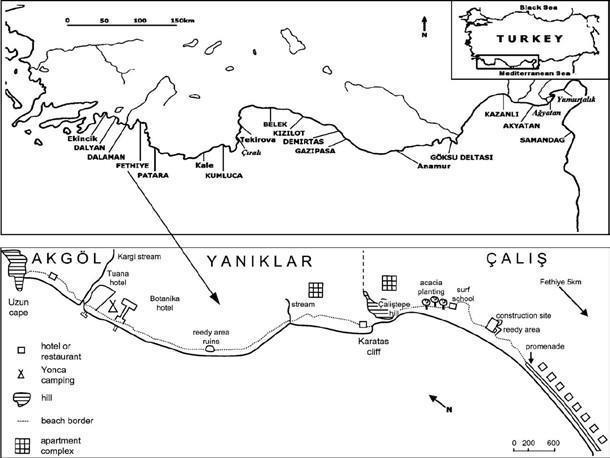
Fig.2. Fethiye SPA, Çalış A. Completed renovations in the promenade area. a) Note the tall street lights facing away from the sea, single line of sunbeds until a point, also wooden zoning posts continuing up to a point, and a caged nest close to the wall (red circle); b) embedded lights (blue circles).

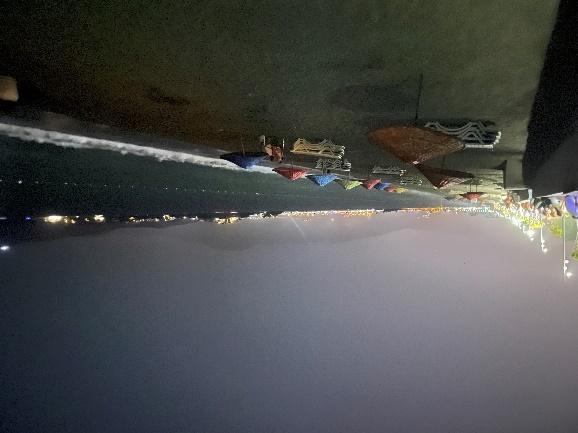
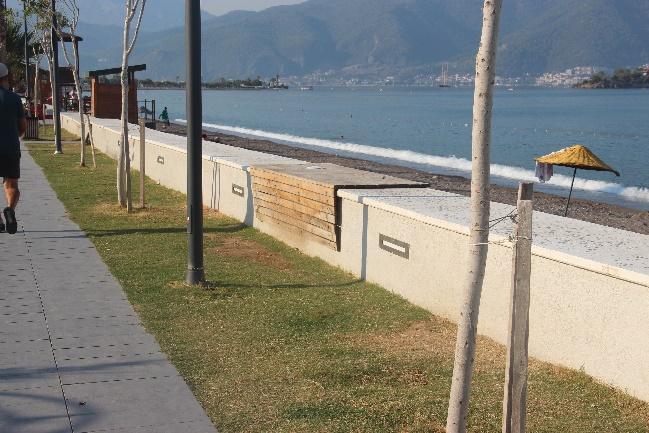

Fig.3.
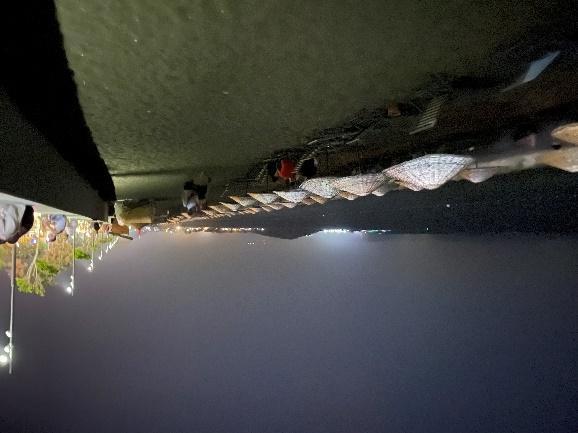
Fig.5. Fethiye SPA, Yanıklar. Large construction area behind Deniz İncisi.

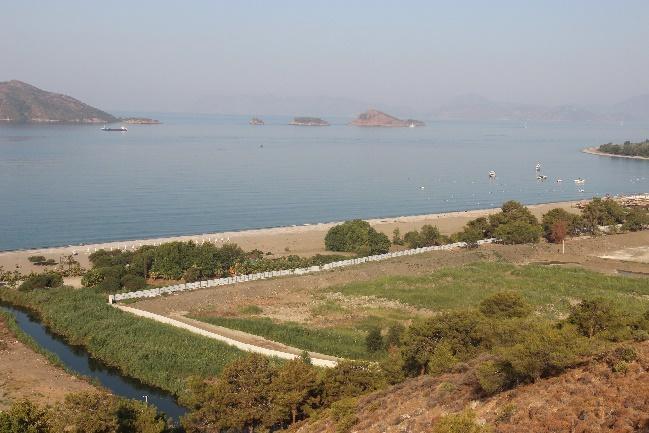
Fig.6. Fethiye SPA, Yanıklar. Fabay Kızılada Apart Houses still under construction behind the hotels.
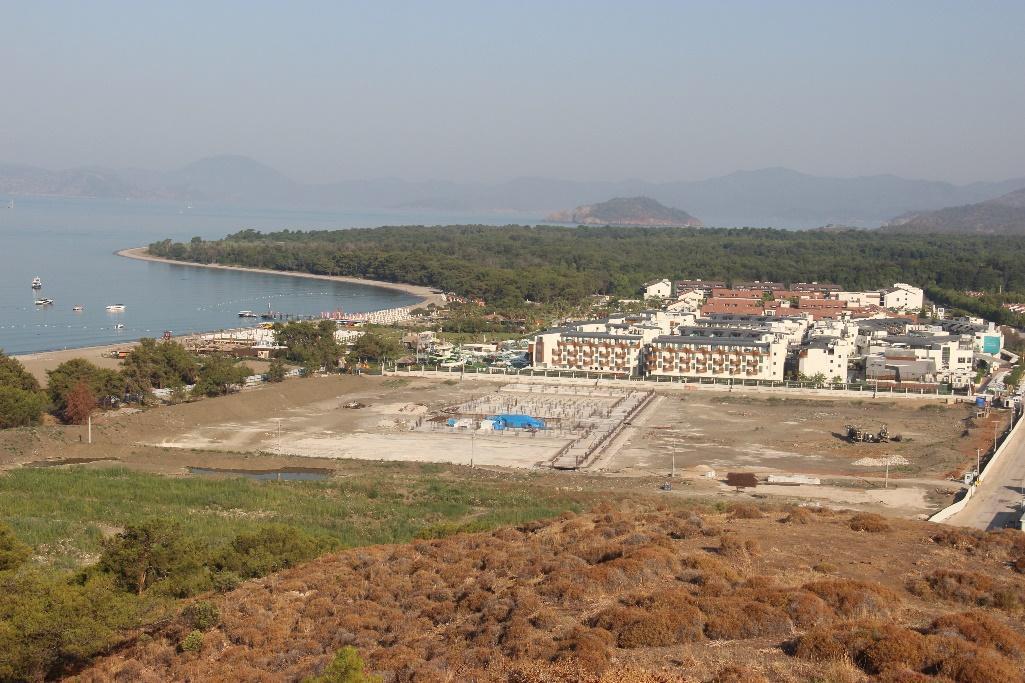

Fig.7. Fethiye SPA, Yanıklar, Akmaz Beach. New facility established on previously public picnic area: “Akmaz Doğa Mesire Yeri (Akmaz Natural Recreation Area)”. Note the lack of zoning posts in the area


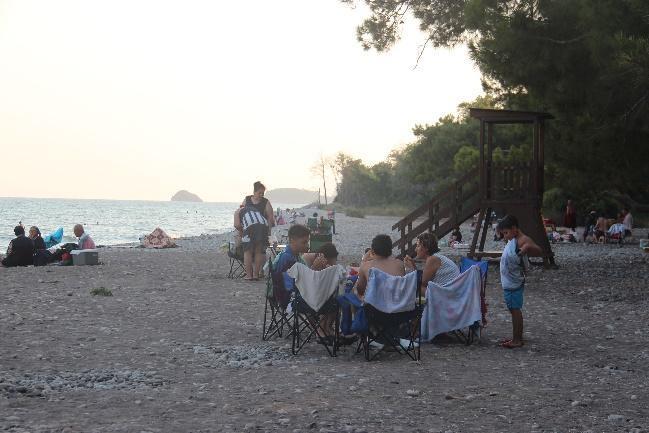
Fig.8. Fethiye SPA, Yanıklar, Akmaz Beach. Signs at the facility prohibit camping, putting up tents, barbecuing, and building fires, without mentioning anything about sea turtles.
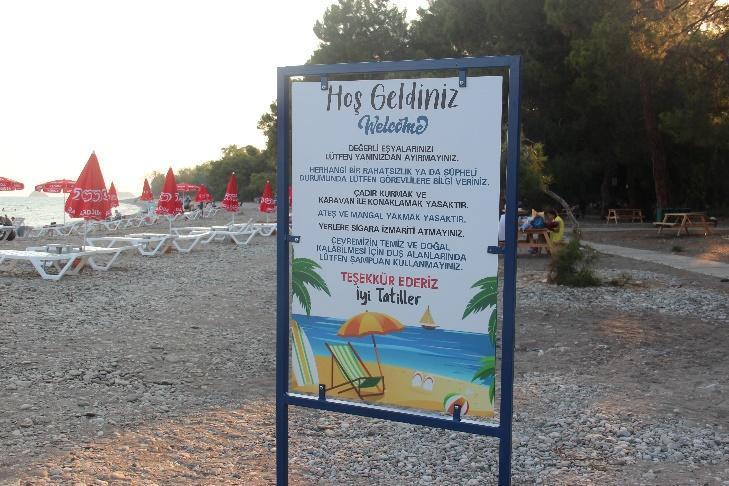
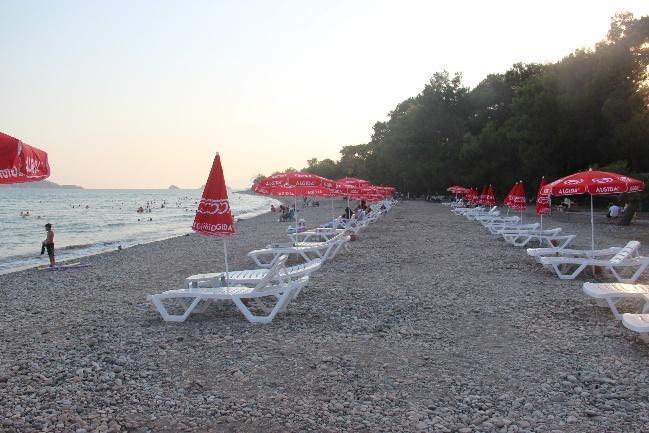

Fig.9. Fethiye SPA, Yanıklar. Lykia Botanika, reopened and enlarged. a) Shades over two rows of sunbeds; b) artificial plantation; c) volleyball pitch and an artificial lawn being watered (red circle).
Fig.10. Fethiye SPA, Akgöl, Karaot. Former Karaot Buffet reopened as “Hayal Café”. Note the old Ministry sign and wooden posts in 10a (red circle); orange Municipality lights in 10a and 10b (blue cirlces).
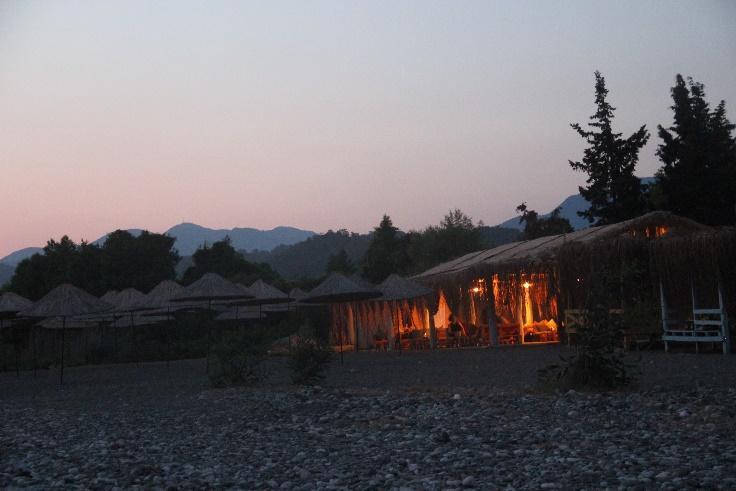
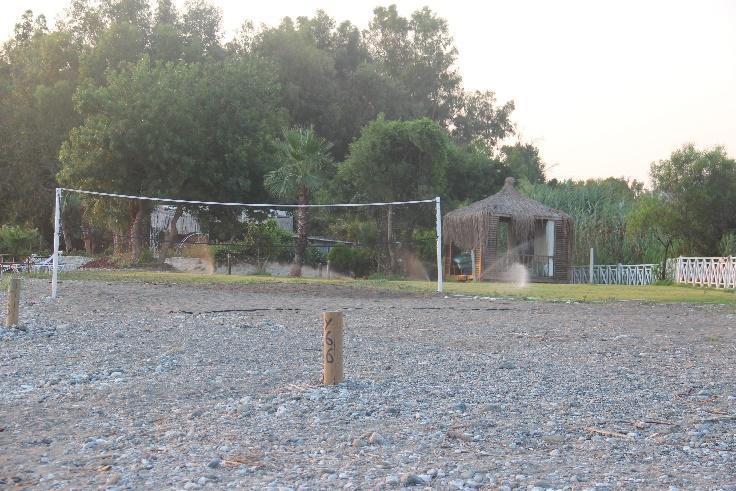
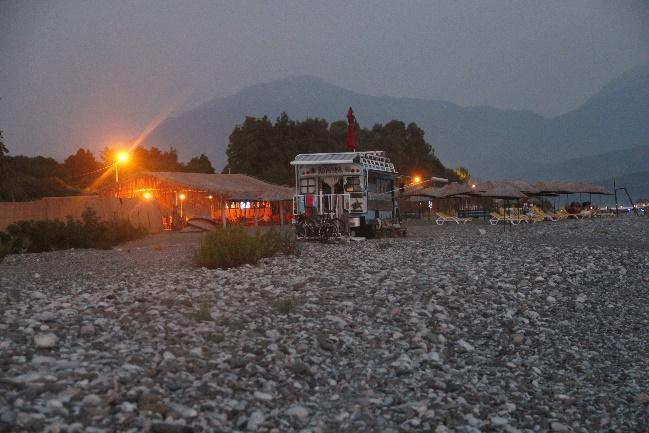

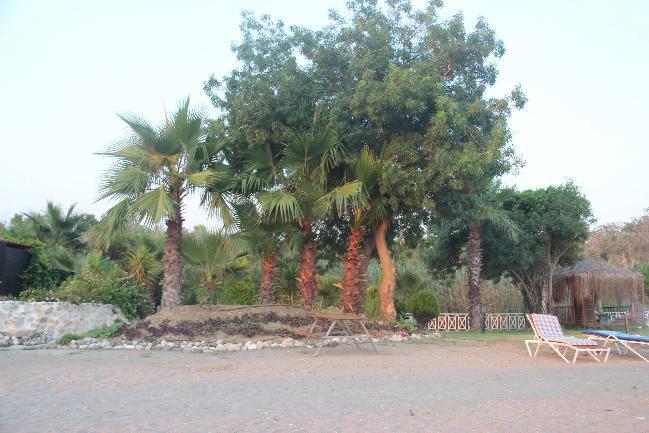

Fig.11. Fethiye SPA, Çalış A. Zoning posts used in limited parts at the beginning and end of the section. Note the single row of sunbeds in 11a and 11b, the new Ministry sign (blue circle) and nest (red circle) behind the posts in 11b, and rod fishing in 11c.
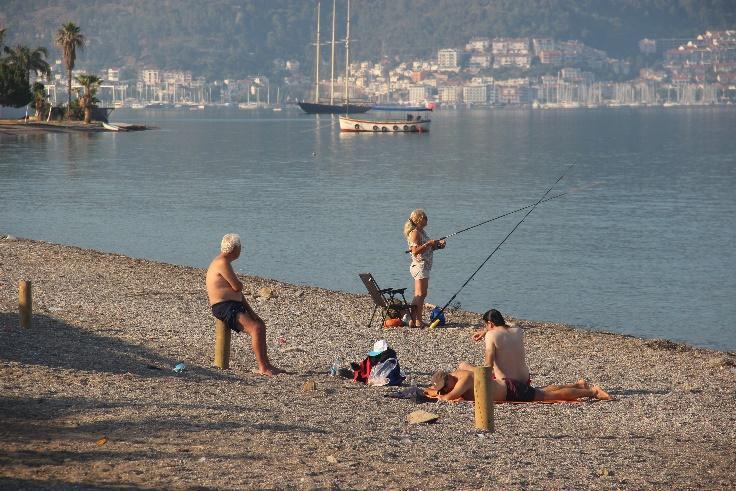
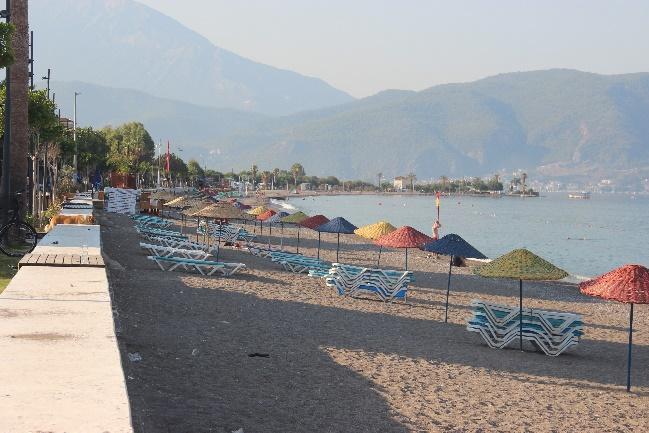


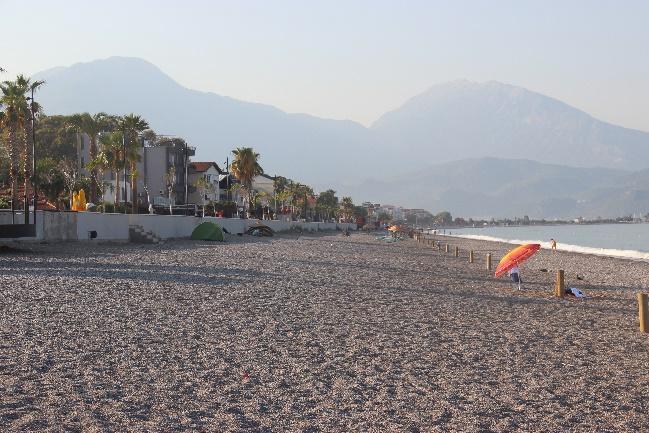




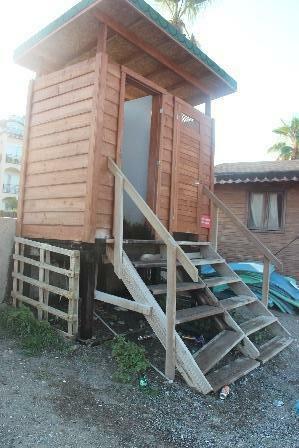
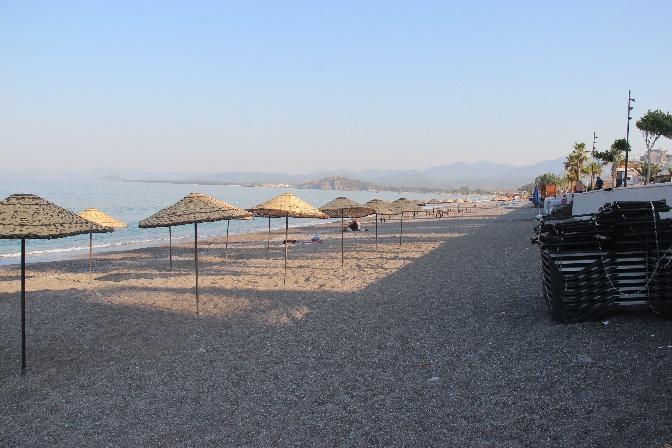
Fig.16.
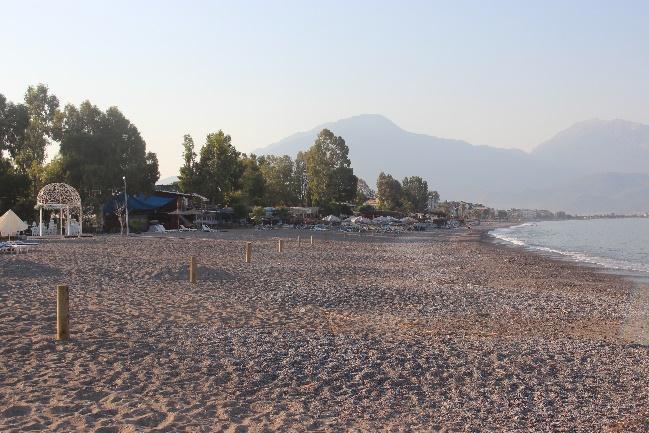
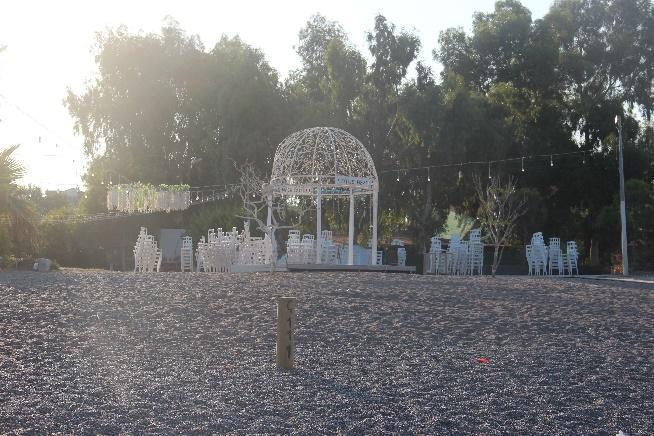
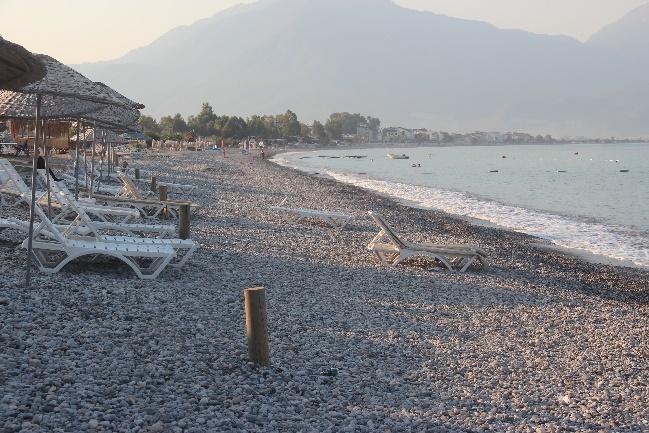

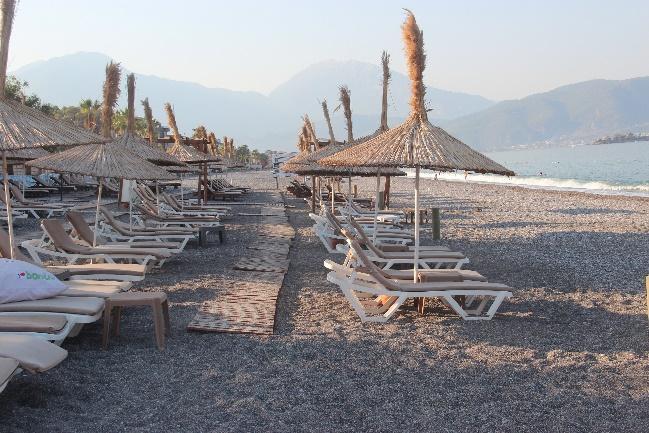
Fig.17.
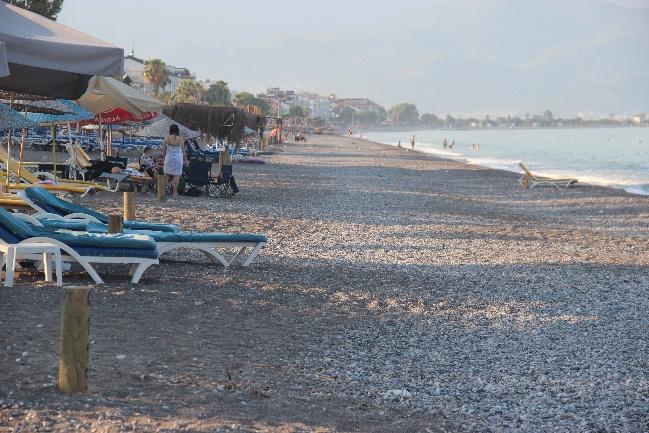
Fig.18.

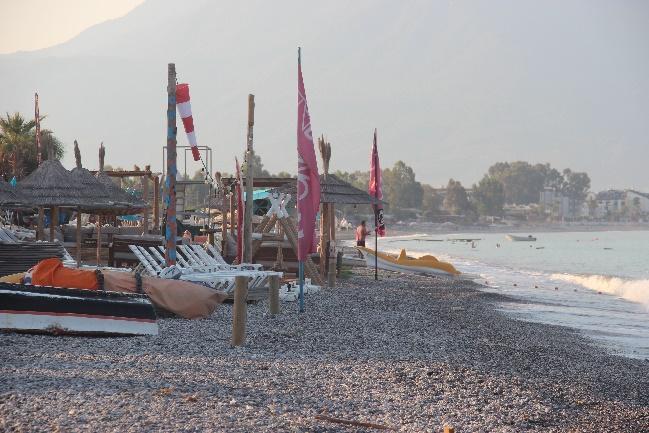
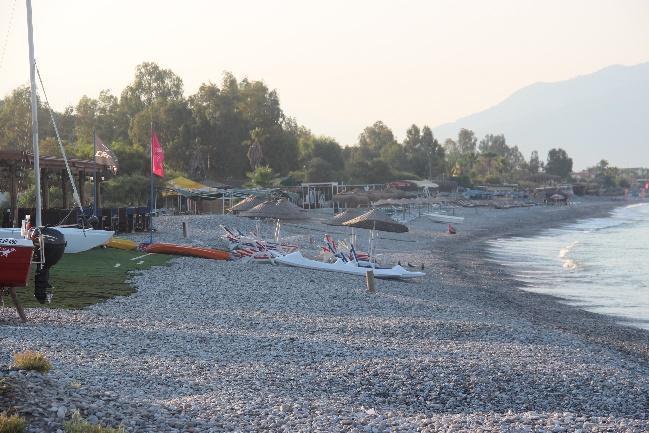

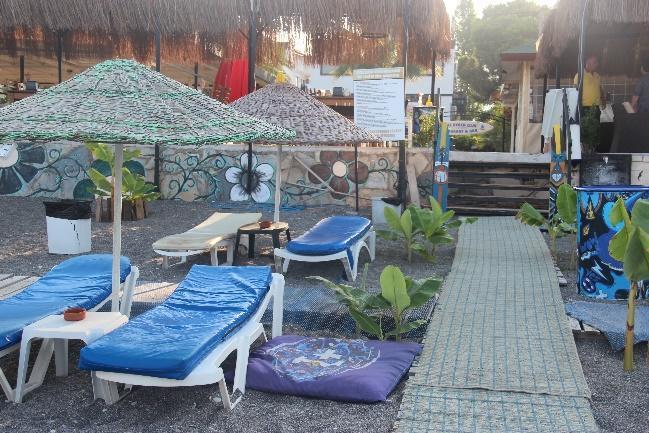

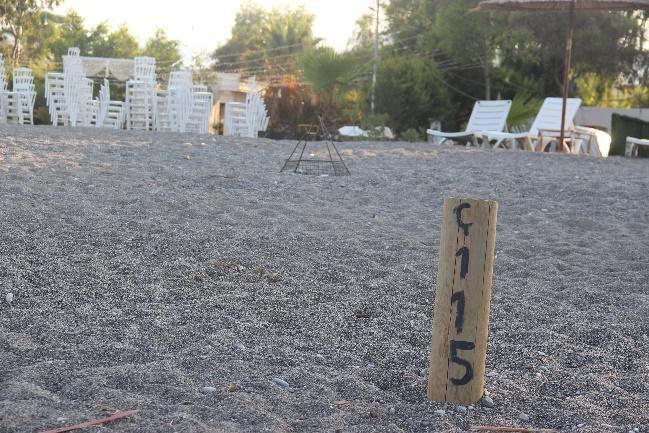
Fig.21. Fethiye SPA, Çalış B. Boat on the nesting beach.
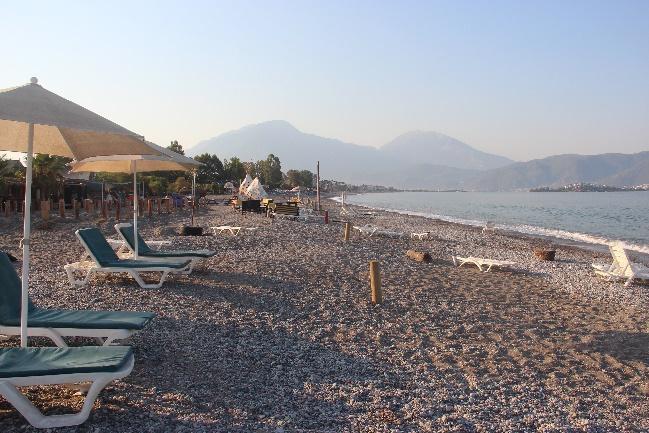
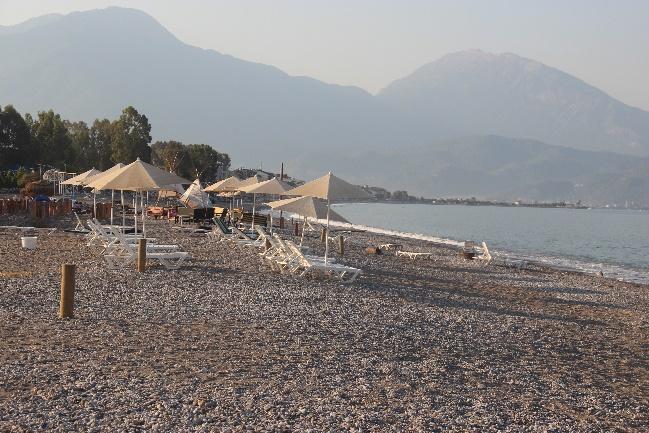
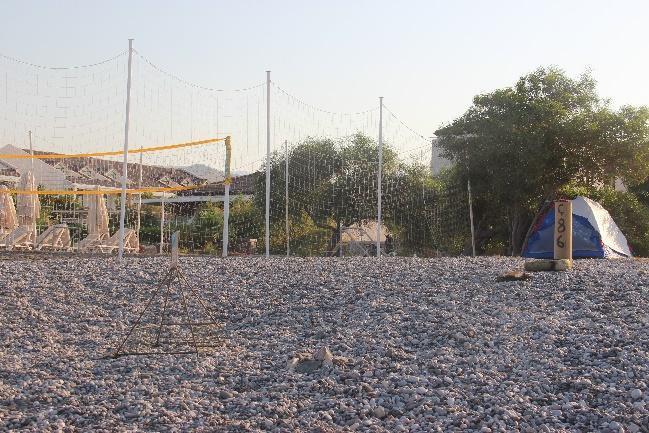
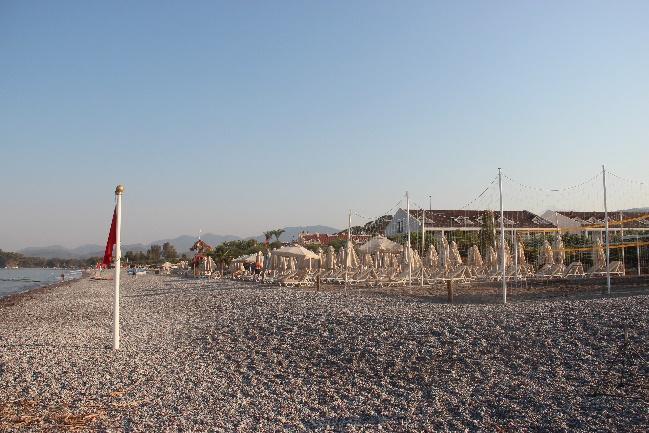
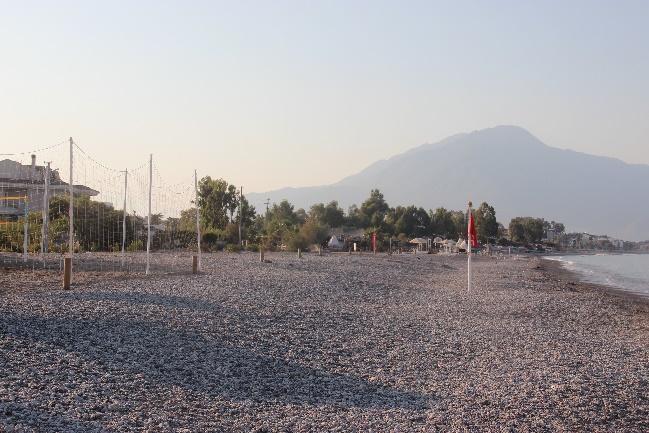
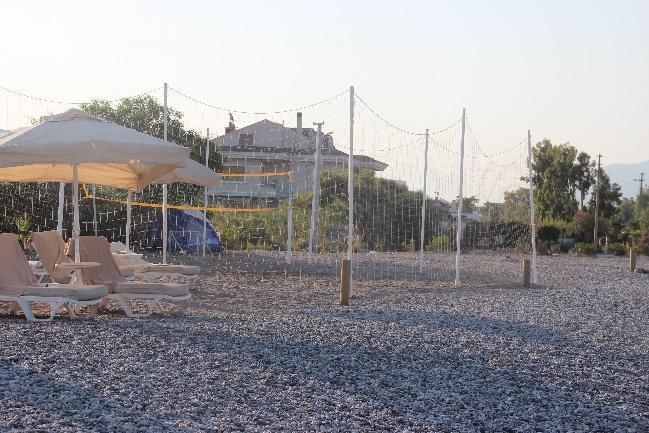
Fig.22.
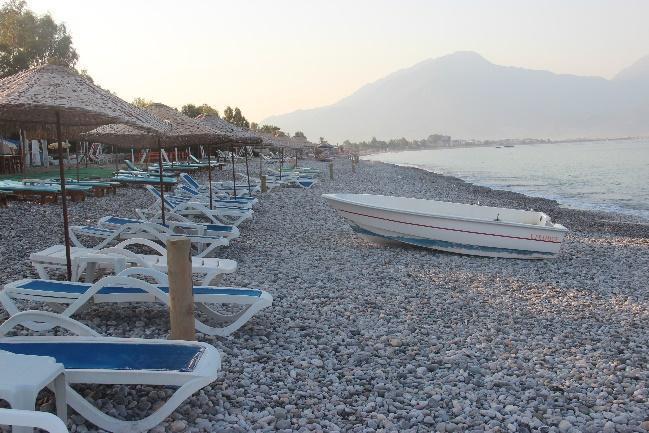
Fig.23. Fethiye SPA, Çalış B, Apache Beach. Noncompliance with new arrangements. Sunbeds and other equipment scattered on the nesting beach, in the nesting zone (red circles).
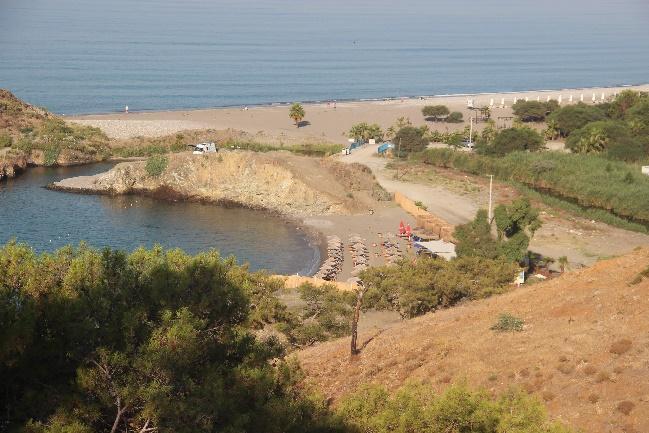
Fig.24. Fethiye SPA, Çalış B, Apache Beach. Wooden stakes erected in the sand, for an unknown purpose and Palm trees planted at the back of the beach.
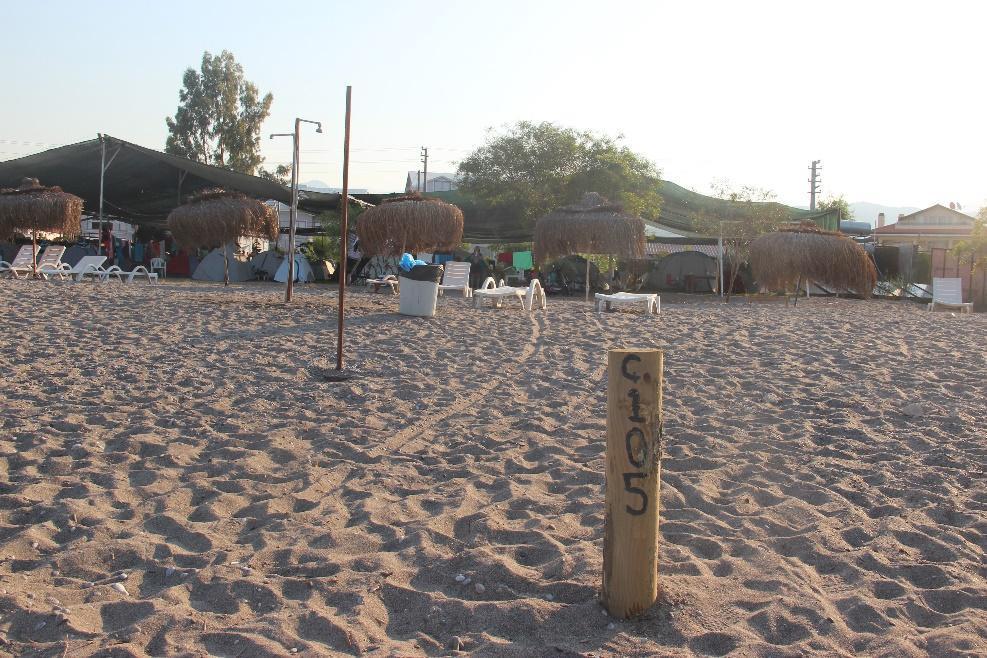

Fig.25. Fethiye SPA, Çalış B, Butik Camping/My Beach. Showers on the beach.

Fig.27. Fethiye SPA, Yanıklar, Deniz İncisi. Single row of sunbeds behind zoning posts, and fixed umbrellas. Note the new Ministry sign (blue circle) in and two umbrellas (red circles) inserted in the sand in 27a; vehicle tracks in 27b.
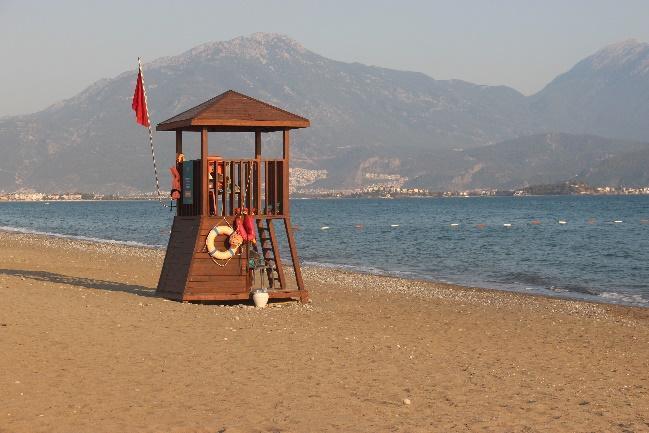
Fig.28. Fethiye SPA, Yanıklar, Deniz İncisi. Visitors randomly inserting umbrellas (red circles) within nesting zone. Note the newly planted oleander (blue circle)

Fig.29. Fethiye SPA, Yanıklar, Hotel Liberty Fabay. Pavilions behind zoning posts located at least 30 metres away from the waterline, and lifeguard tower within the nesting zone. Note palm trees between sunbeds.

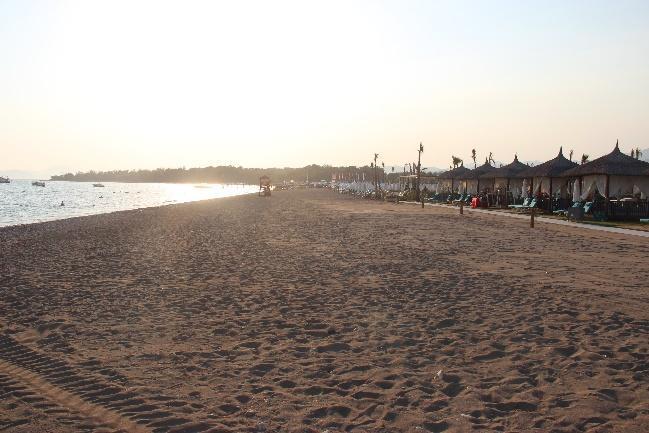
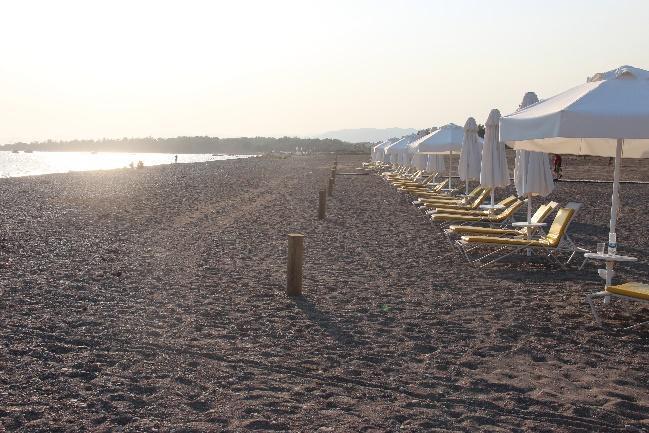

Fig.30. Fethiye SPA, Yanıklar. Water sports area between the two big hotels, keeping a high number of sea vehicles on the nestingbeach. Note palmtrees between sunbeds 30b & c.

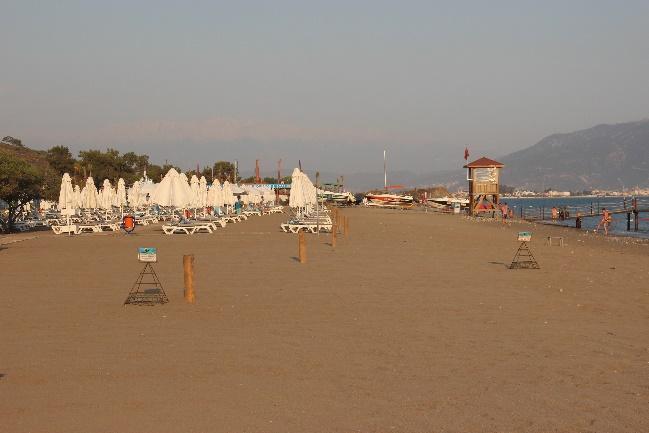
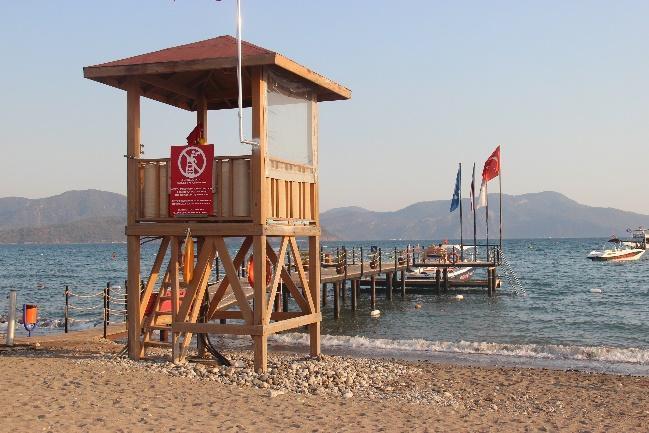
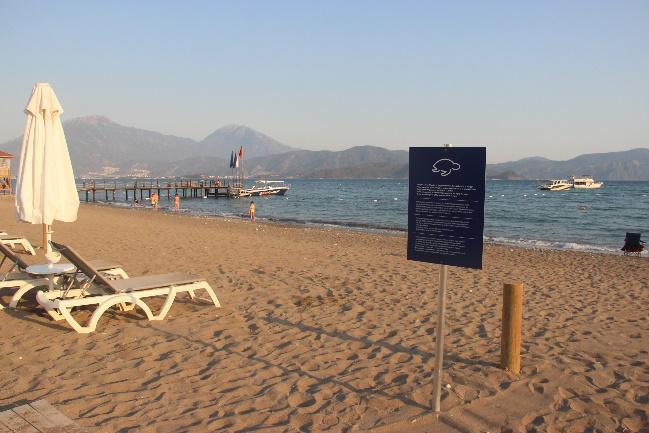
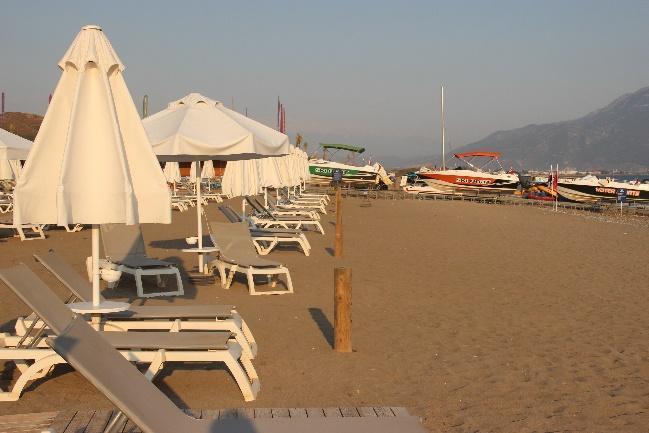

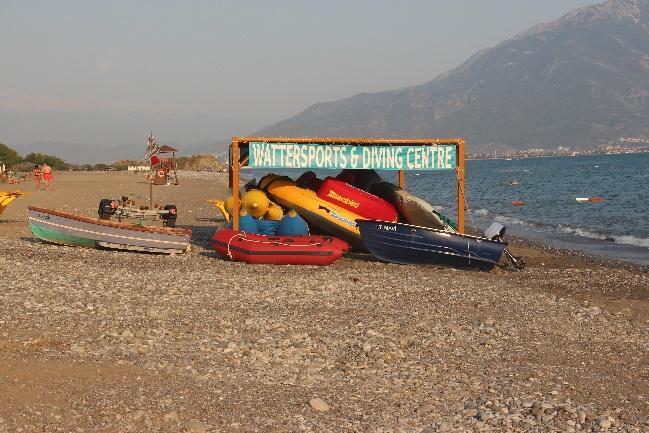
Fig.33. Fethiye SPA, Yanıklar, Hotel TUI BLUE Sensatori Barut. Vertical wooden away from the sea, with sunbeds and umbrellas behind. Note the nest cages (red circles), and artificial plantations (red dashed line) behind the beach.
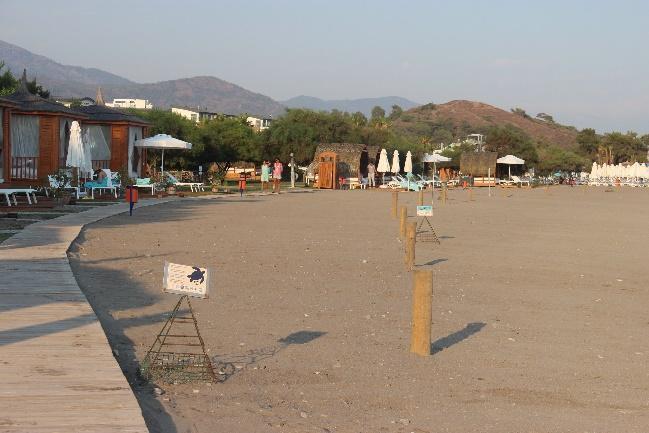
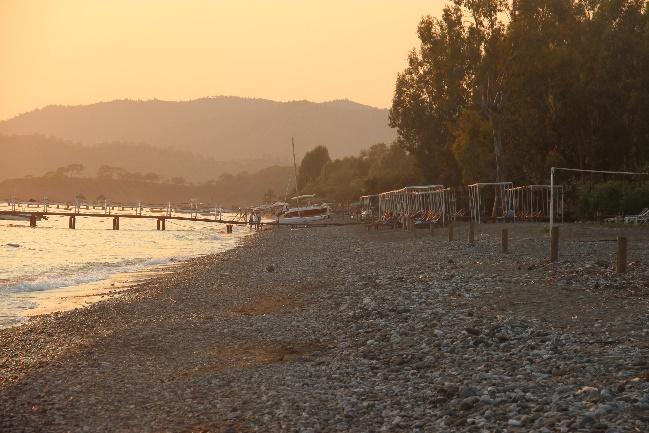
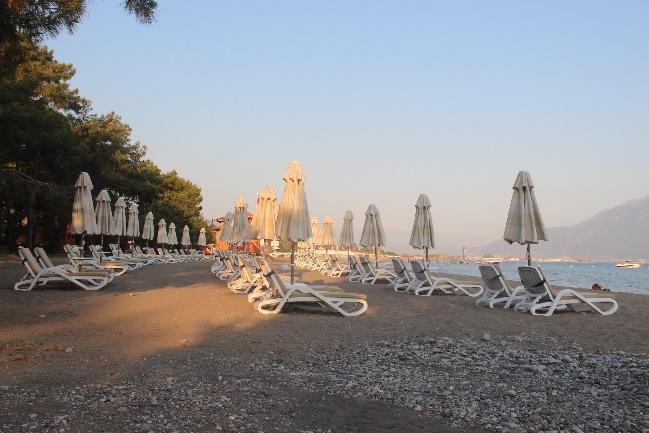
Fig.35.

Fig.36. Fethiye SPA, Yanıklar, Yonca Lodge. (a & b) Lot of tents, picnic tables, (b & c) a volleyball court, (d) large holes dug in the sand, (a c) acacia trees, and (e) showers on the nesting beach. Note the drainage in 36a.

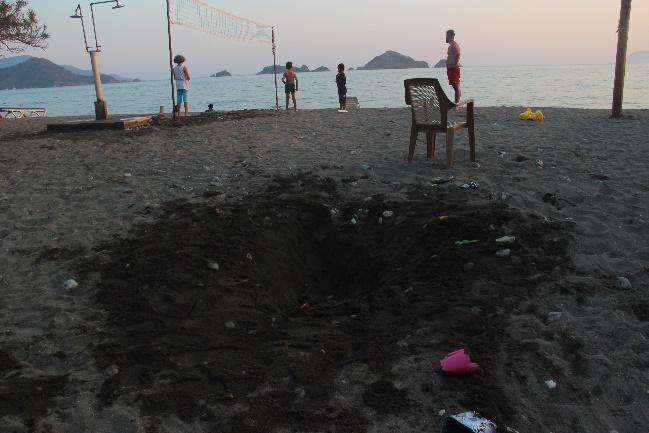
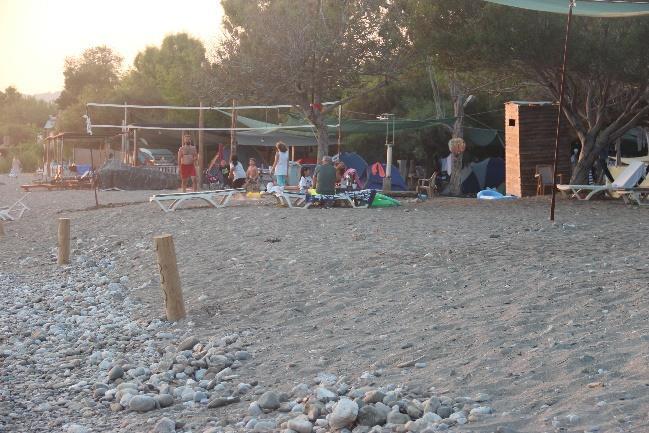
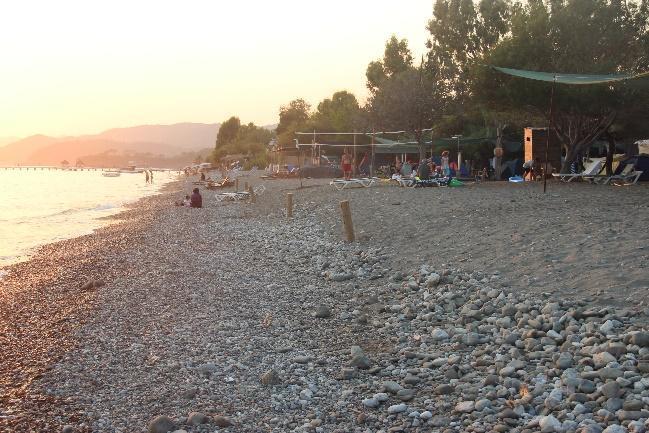
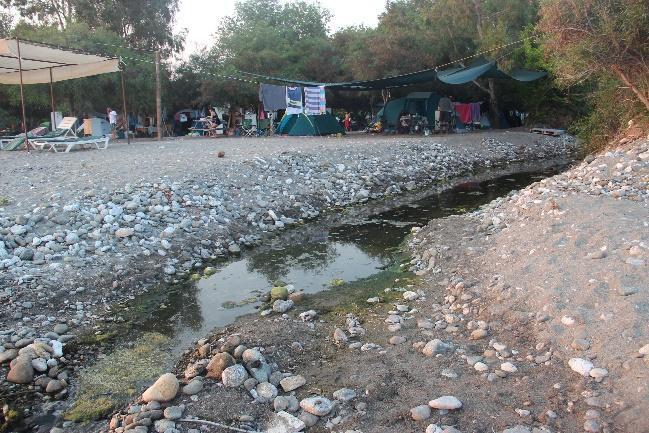
Fig.37. Fethiye SPA, Yanıklar. Water sports area with equipment (red circles) left on the nesting beach day and night, between Okaliptus Beach and Club Tuana. Note the quay lights in 37a and the very bright security light between two hotels in both photographs.

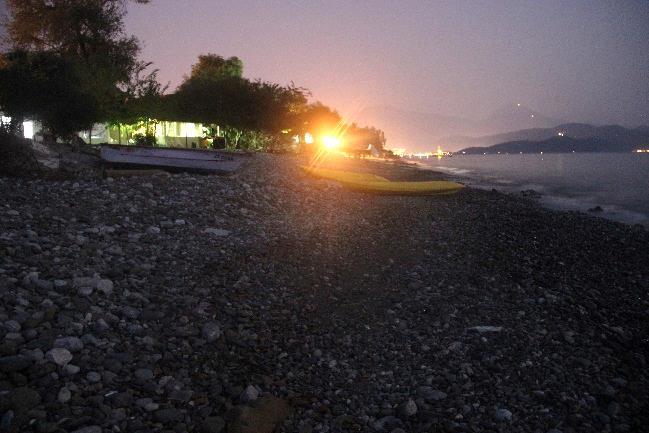

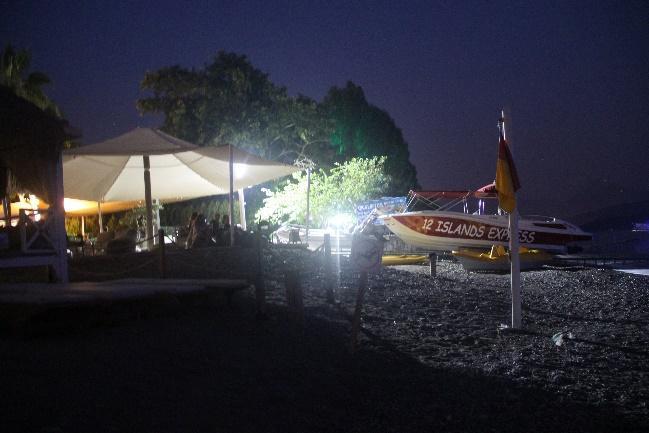

Fig.38. Fethiye SPA, Yanıklar. Random boats (red circles) left on the beach, in the nesting zone, overnight near Okaliptus and Tuana.
Fig.39. Fethiye SPA, Yanıklar, Katrancı Hotel. Single row of sunbeds behind zoning posts, and another row of shaded gazebos at the back. Also note the acacia trees remain, in disregard to Rec 182 #4.
Fig.41.
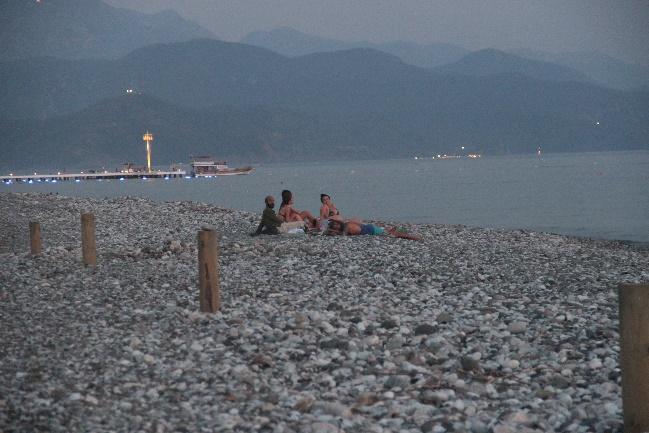



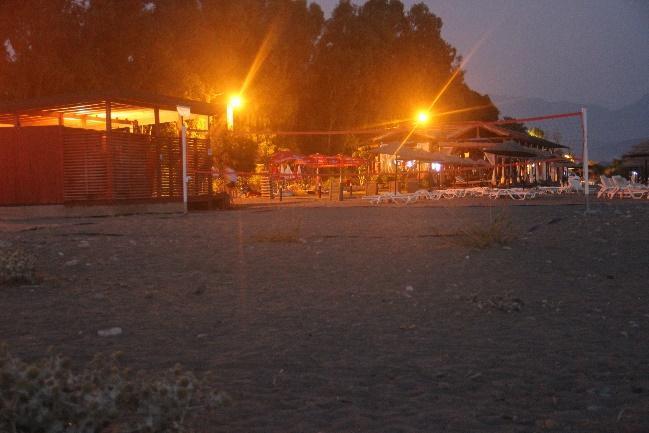
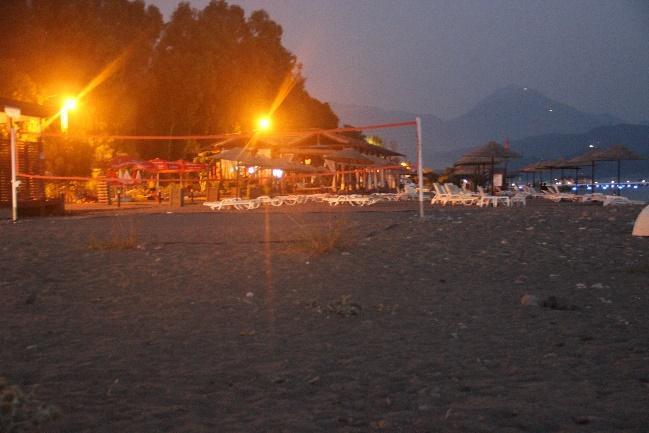
Fig.44.

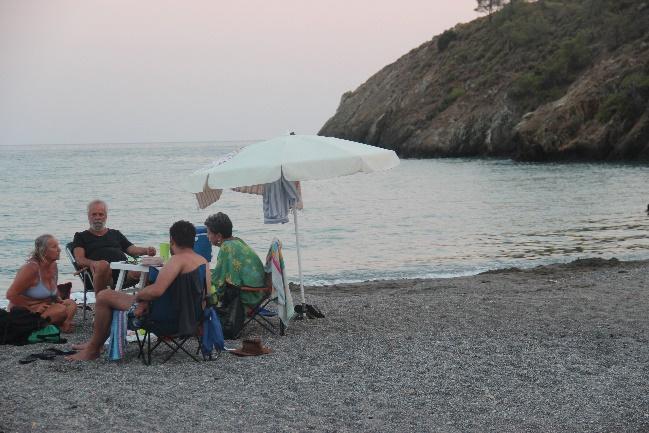
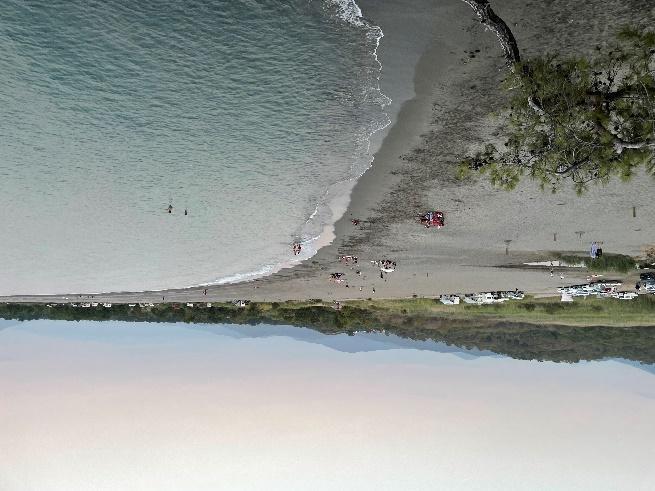


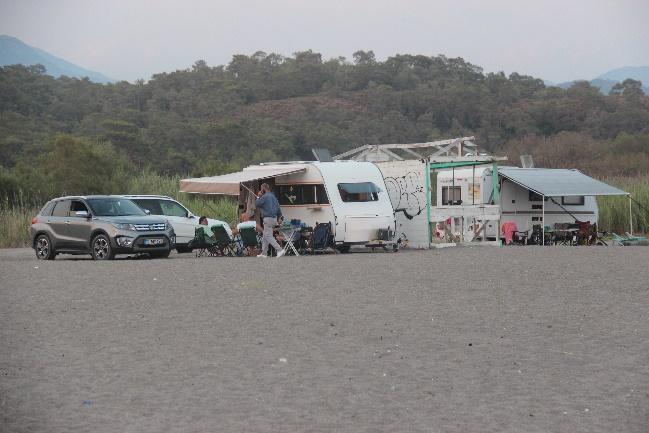
Fig.45.
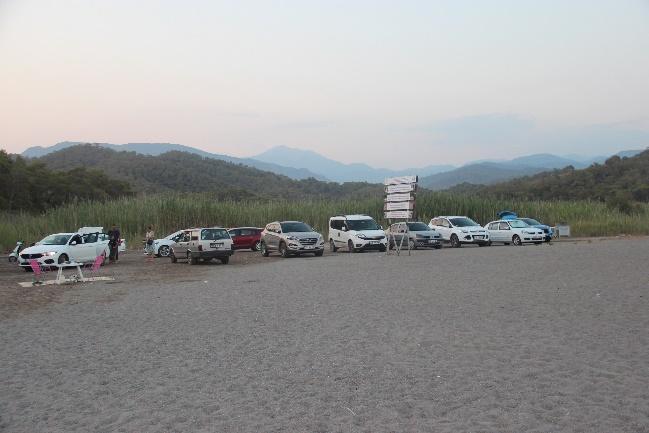
Fig.47.
Fig.48. Fethiye SPA, Çalış A, Sundia. Erecting a new umbrella (red circle) on the nesting beach at night.


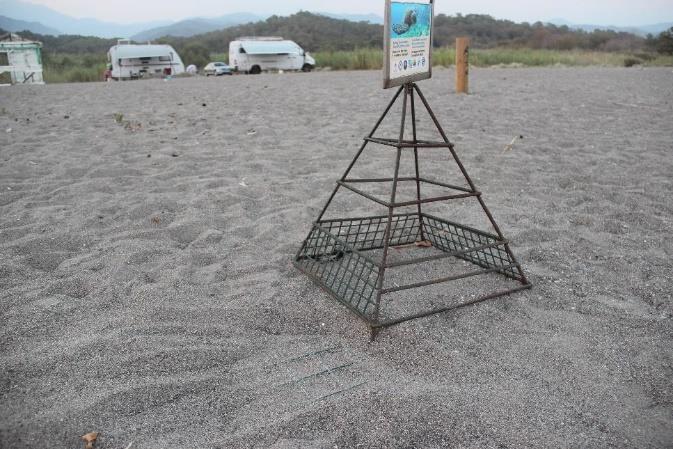
Fig.49. Fethiye SPA, Çalış B. Majority of facilities using dim orange lights at night. Note the erroneous zoning, evidenced by how close the zoning posts are to the waterline (red arrows).
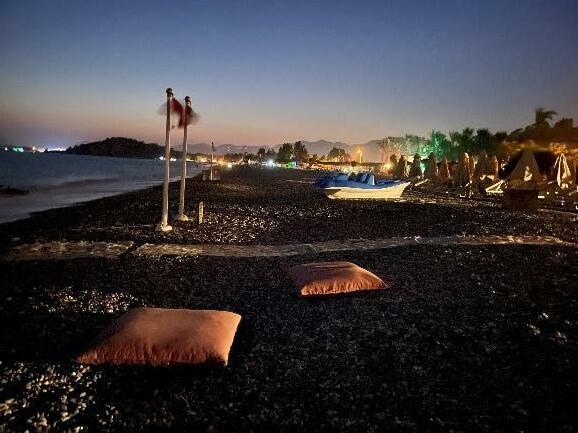
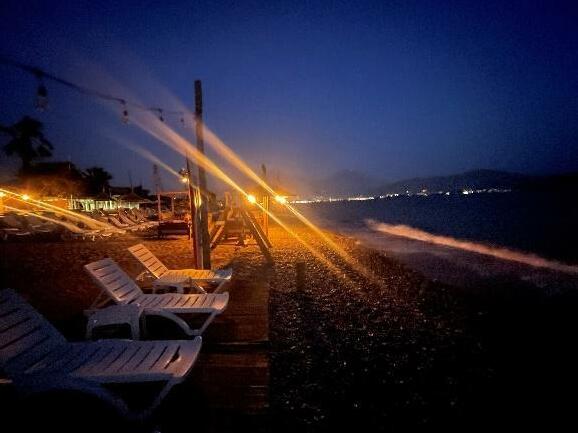

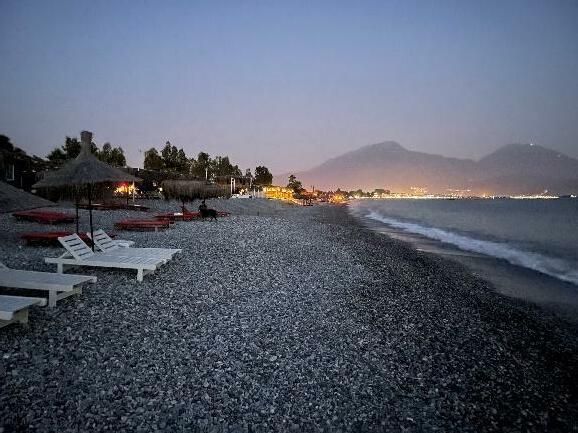

Fig.50. Fethiye SPA, Çalış B. Heavy light pollution at Butik Beach and Apache Beach.
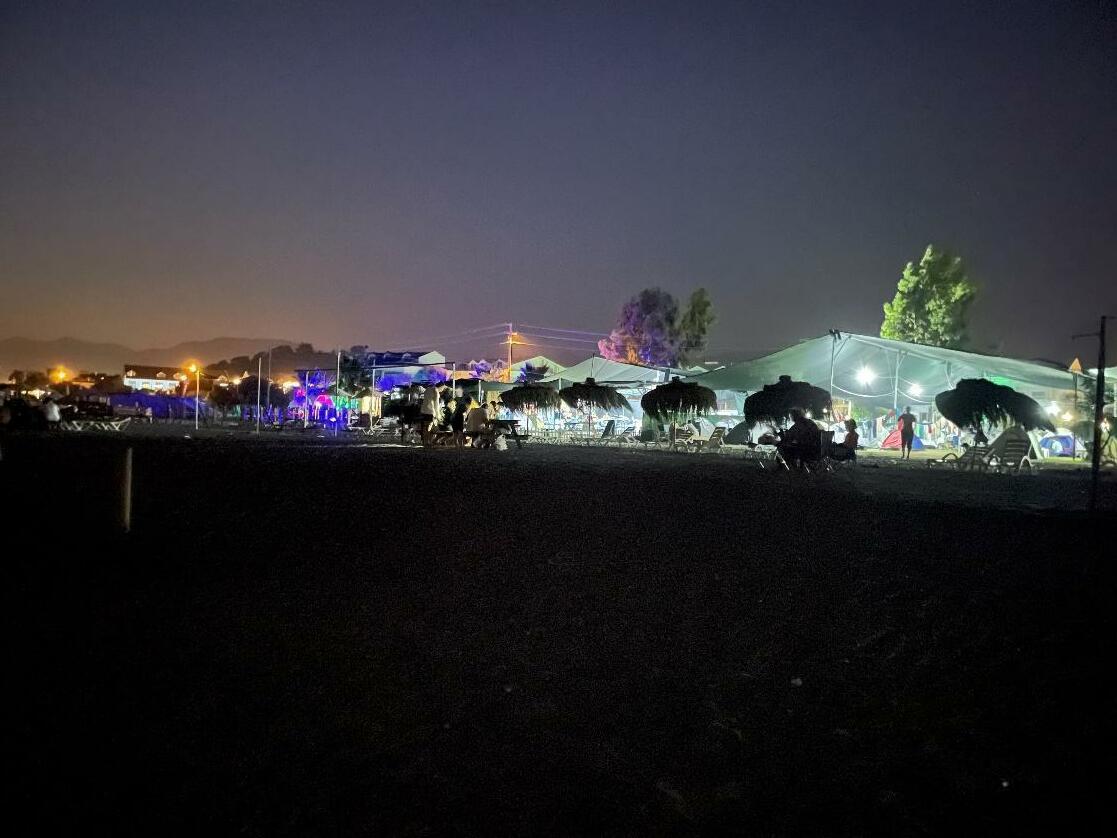
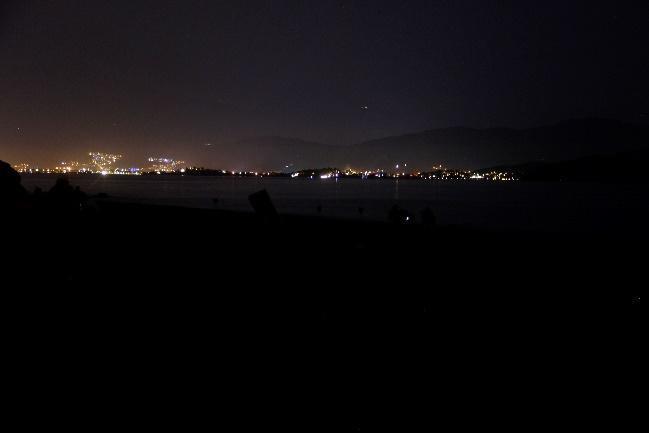
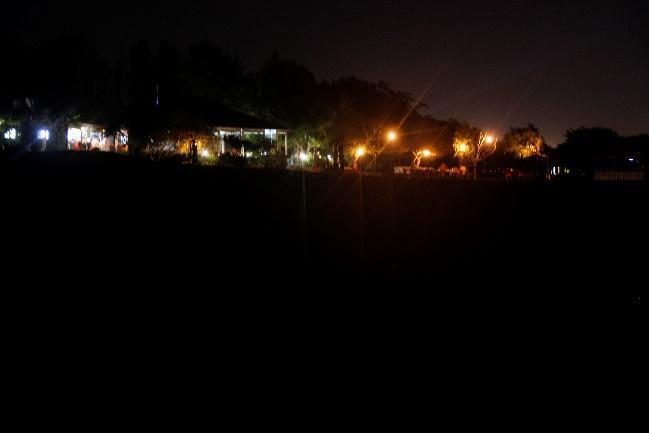
Fig.51. Fethiye SPA, Çalış B. The northernmost part used as a caravan parking and picnic area, with no sandy beach left.

Fig.52. Fethiye SPA, Yanıklar, Deniz İncisi. a) Dim lights of the facility; b) entirely dark nesting zone.
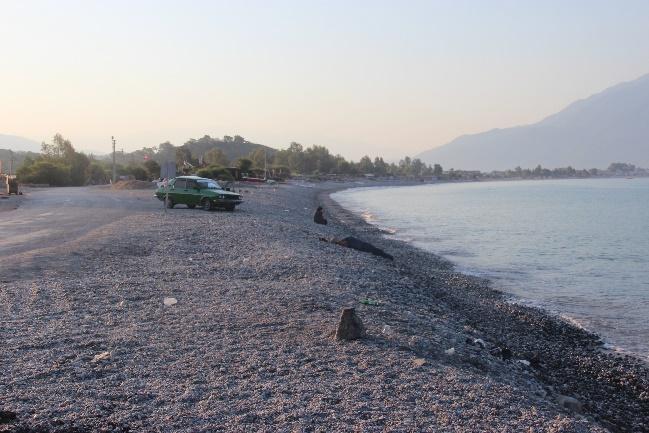
Fig.53.
Fig.54. Fethiye SPA, Yanıklar. The quay between two big hotels illuminated with green and purplish blue lights, dimmer than last year.
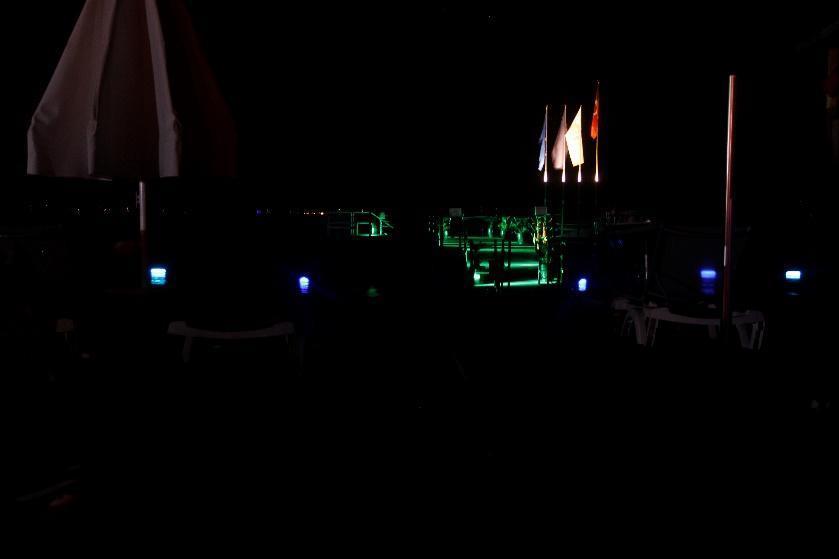
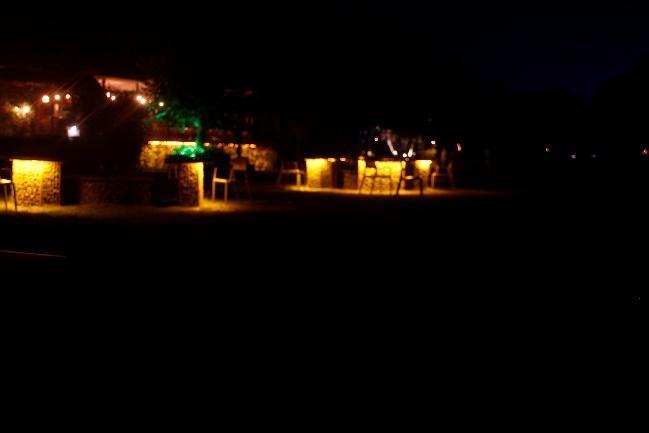
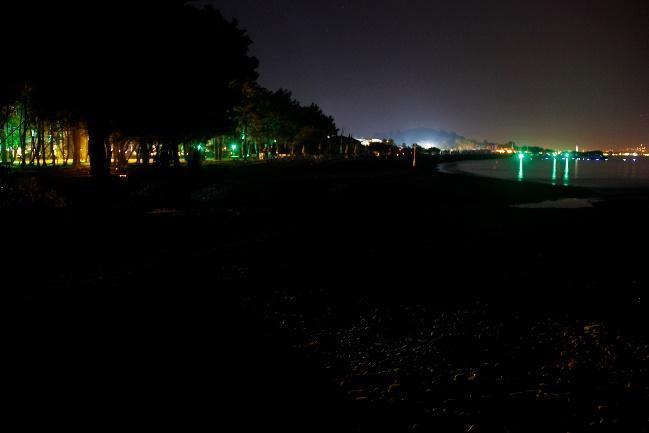
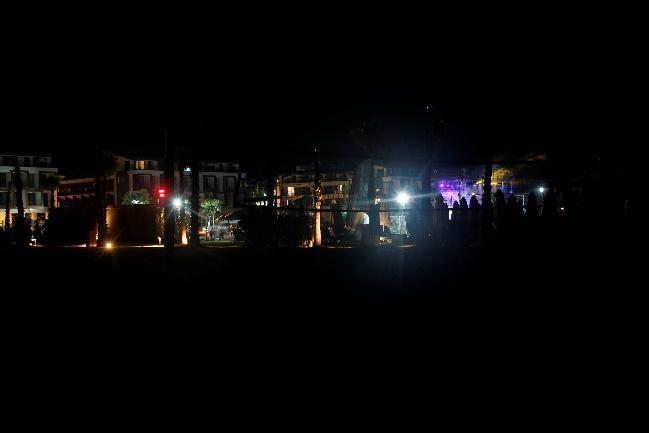
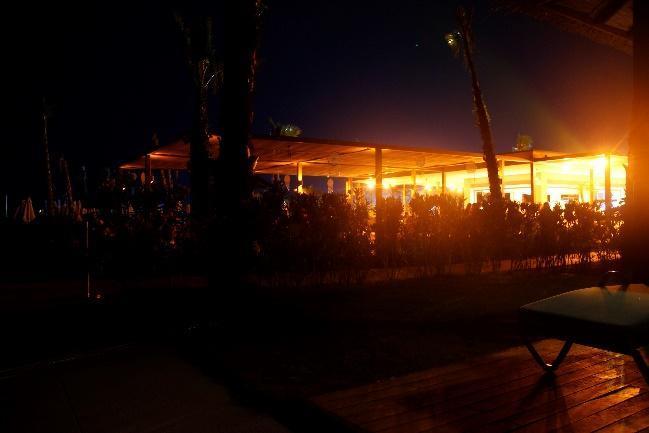
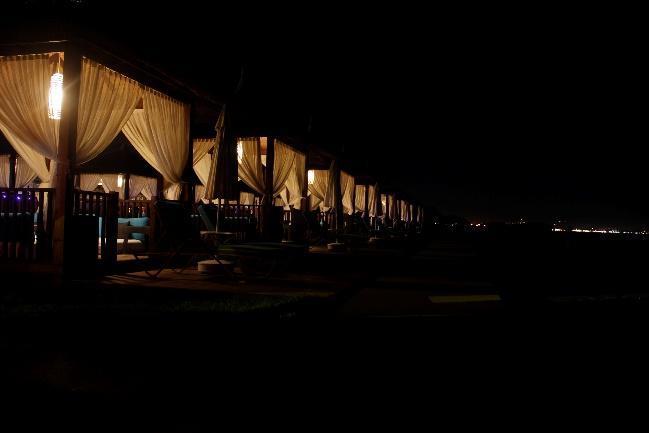
Fig.55.

Fig.57.
Fig.58. Fethiye SPA, Yanıklar. Plastic drainage pipe outlet at the base of security light’s post between Okaliptüs and Tuana.


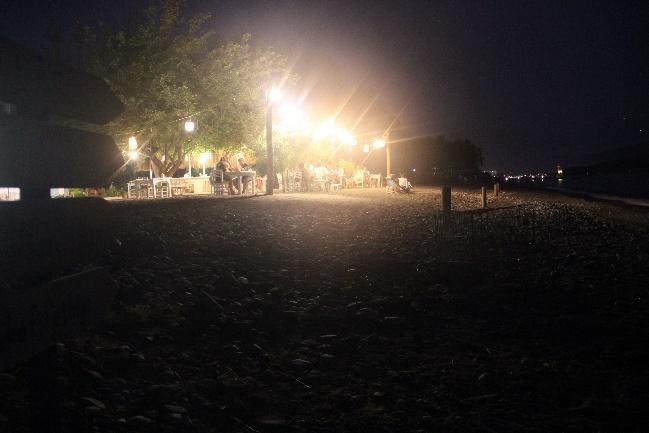

Fig.60.
Fig.61. Fethiye SPA, Akgöl. Caravans being careful about light usage at night. Note the orange Municipality lights.


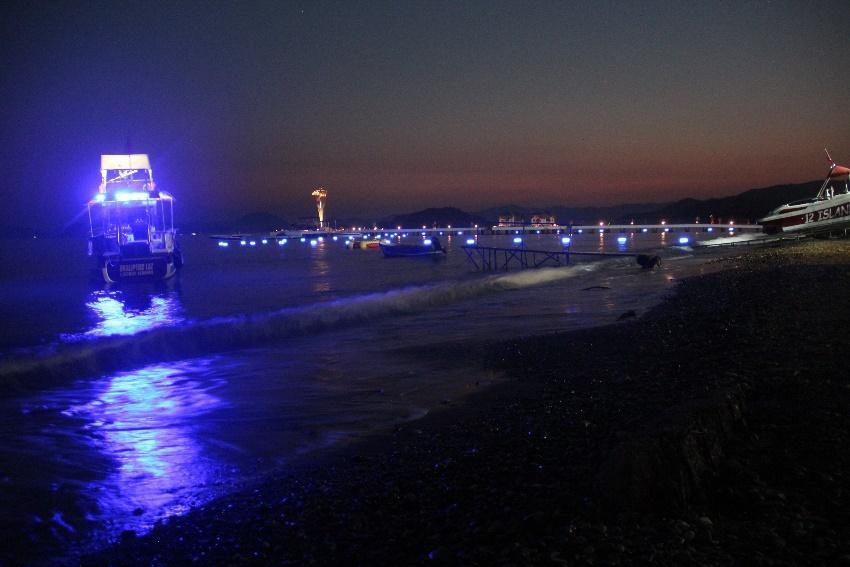
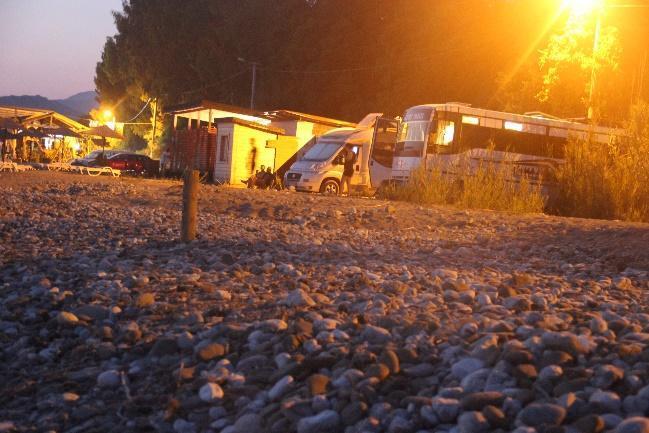
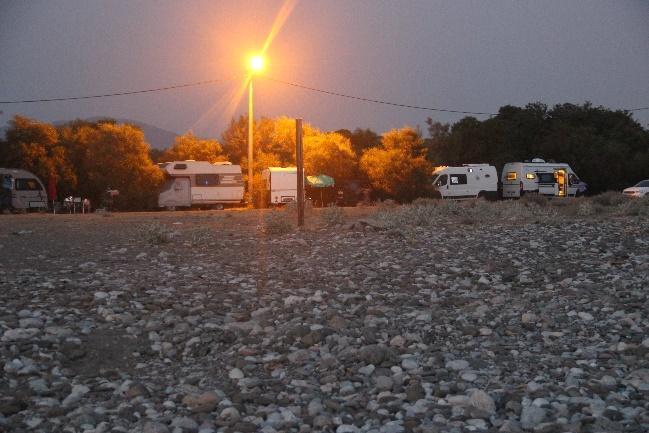
Fig.63.
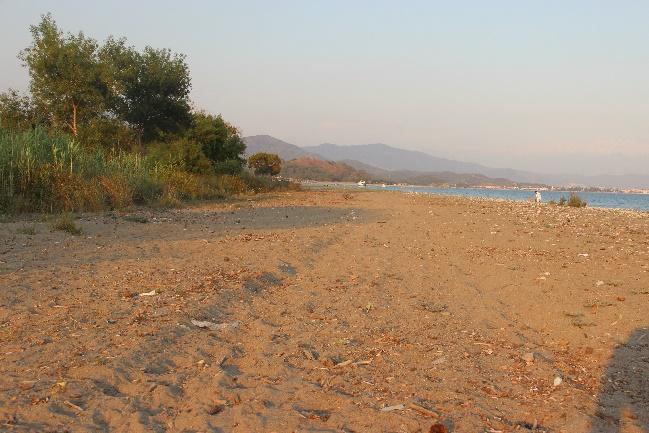

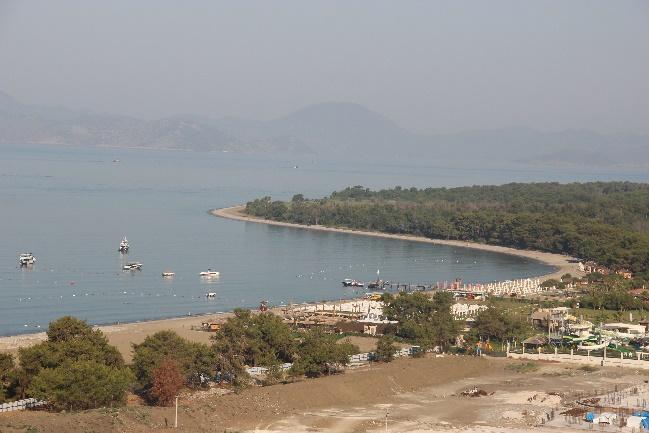
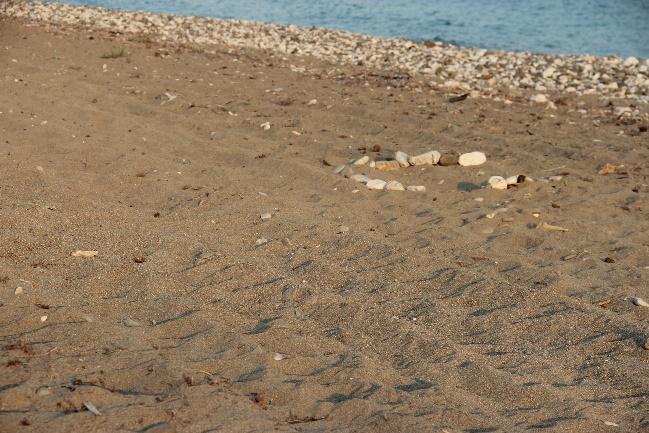

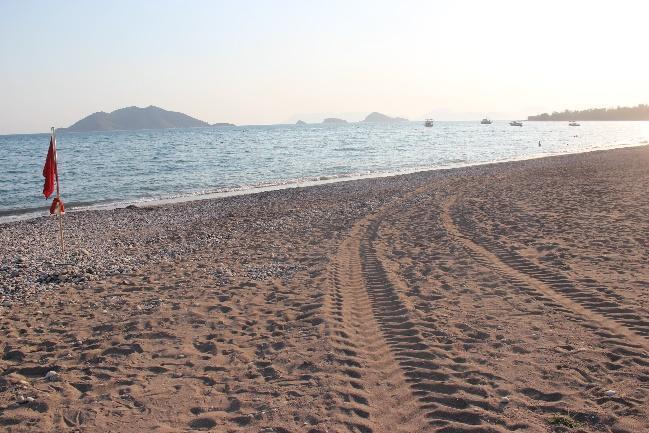

Fig.66.

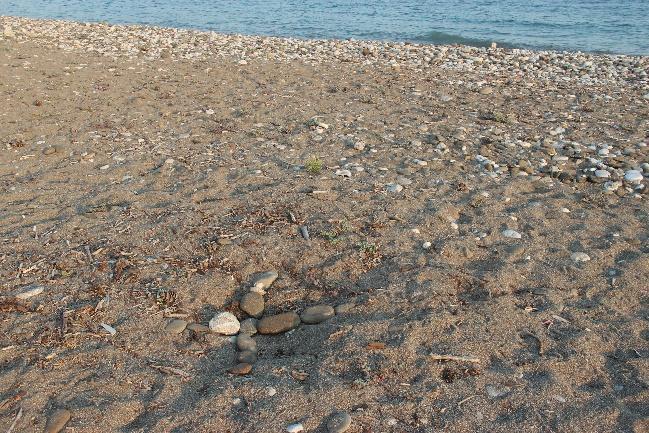

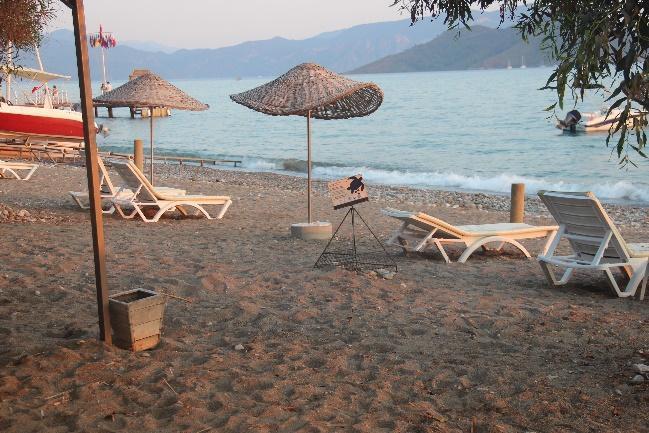

Fig.67.
Fig.69. Fethiye SPA, Çalış A. Municipality emptying bins along the promenade area, around 07.30.
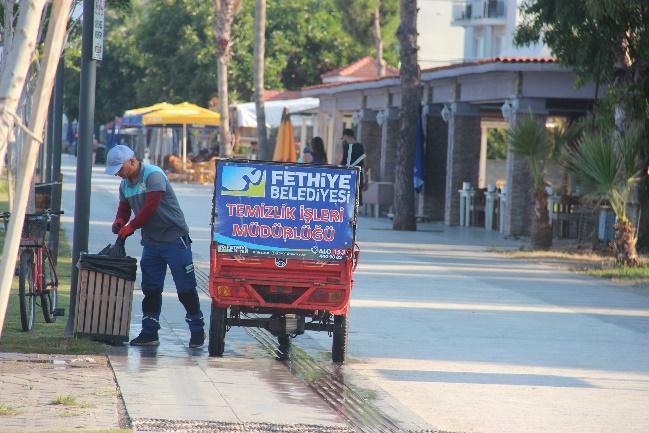

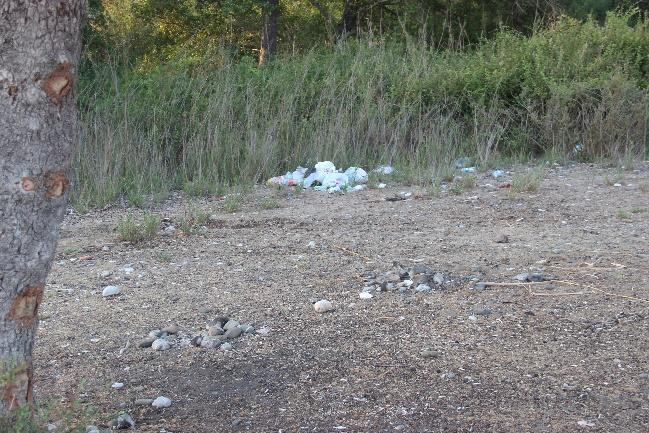
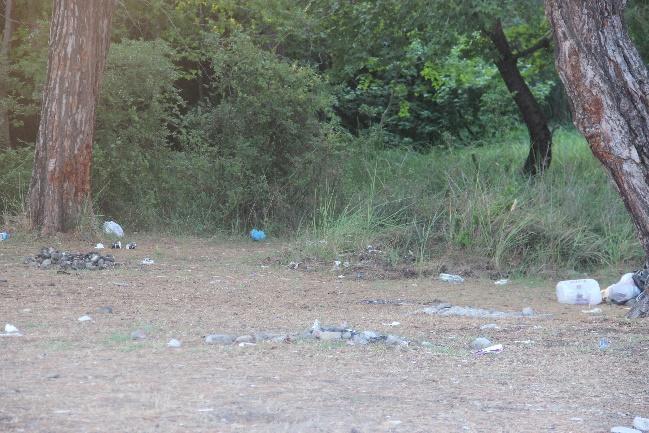
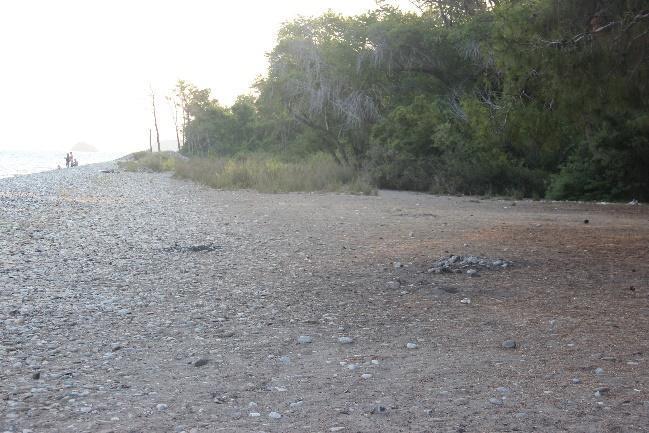


Fig.70. Fethiye SPA, Yanıklar. Litter left by a tree in the pristine section.

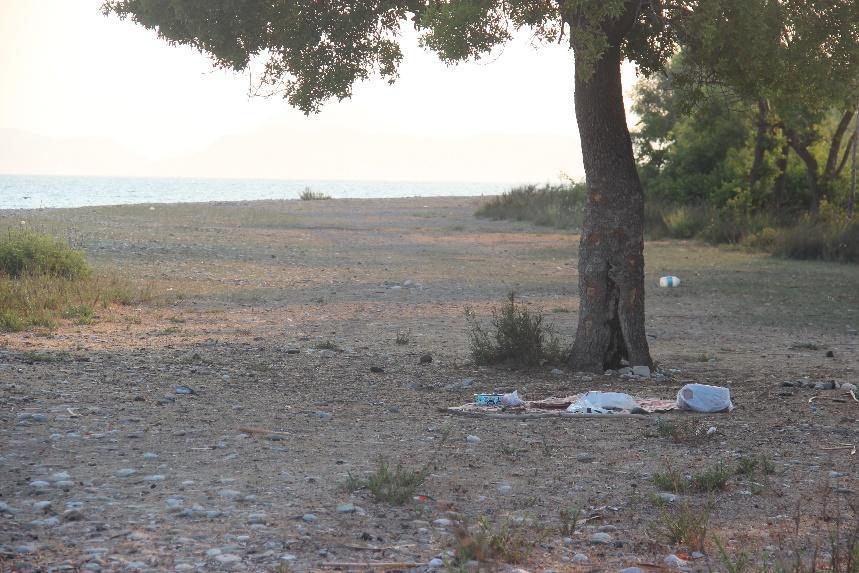
Fig.71. Fethiye SPA, Yanıklar. Fishing line remains in the pristine section.
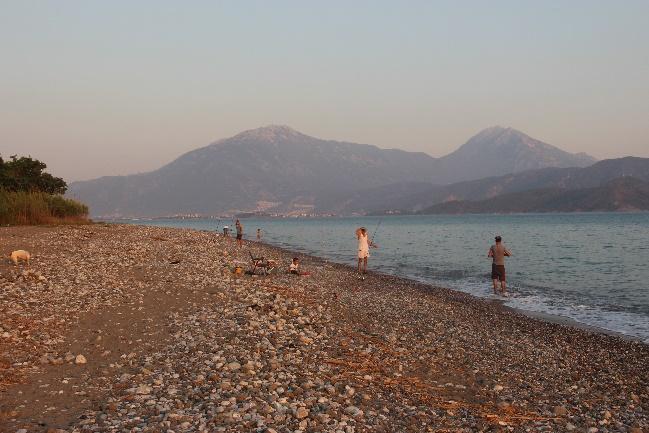
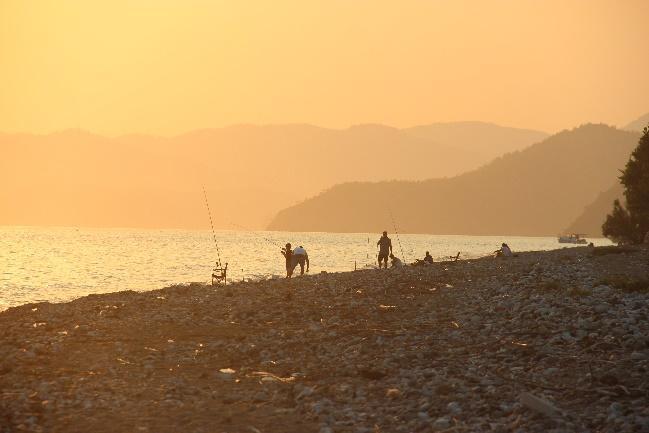
Fig.73. Fethiye SPA, Çalış A B. Renewed Ministry signs (bearing the Ministry’s new name). Note the vertical walkways in 73b (Last Stop Café).
Fig.74. Fethiye SPA. Old Ministry signs bearing the Ministry’s old name; a) near the caravan park area in Kızılot (Akgöl) and b) at the southern end of Çalış A, next to beach usage rules.
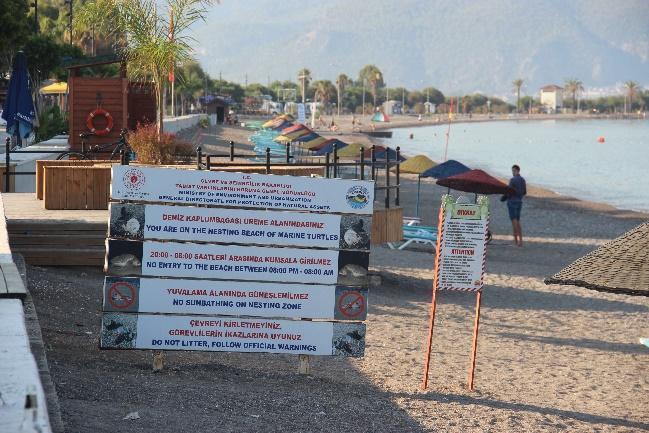
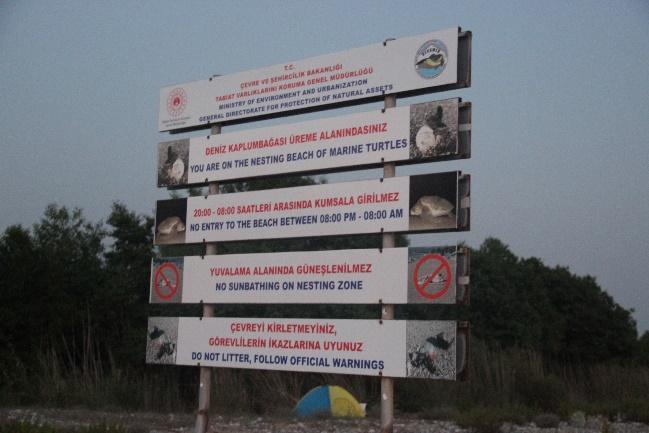
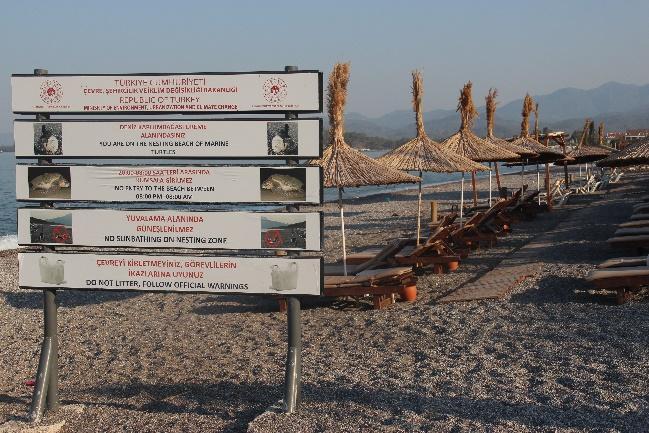

Fig.75. Fethiye SPA, Çalış B, Hanel Houses. Sign prohibiting moving sunbeds beyond zoning posts.
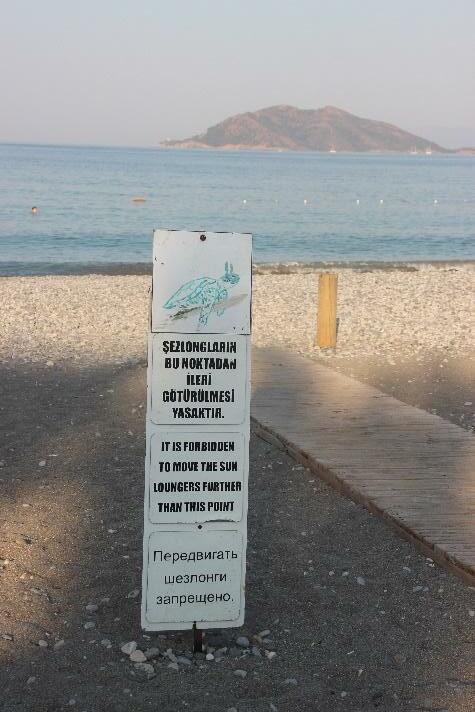
Fig.76. Fethiye SPA, Yanıklar, Lykia Botanika. Text error on the facility’s sign, reading “You can step on my nest...”. Facility politely warned regarding the wrong context.
Fig.77. Fethiye SPA, Yanıklar. Protective grills against predation in the pristine section. Cage covered after checking and taking a photograph. Note the semi circle made by large pebbles.

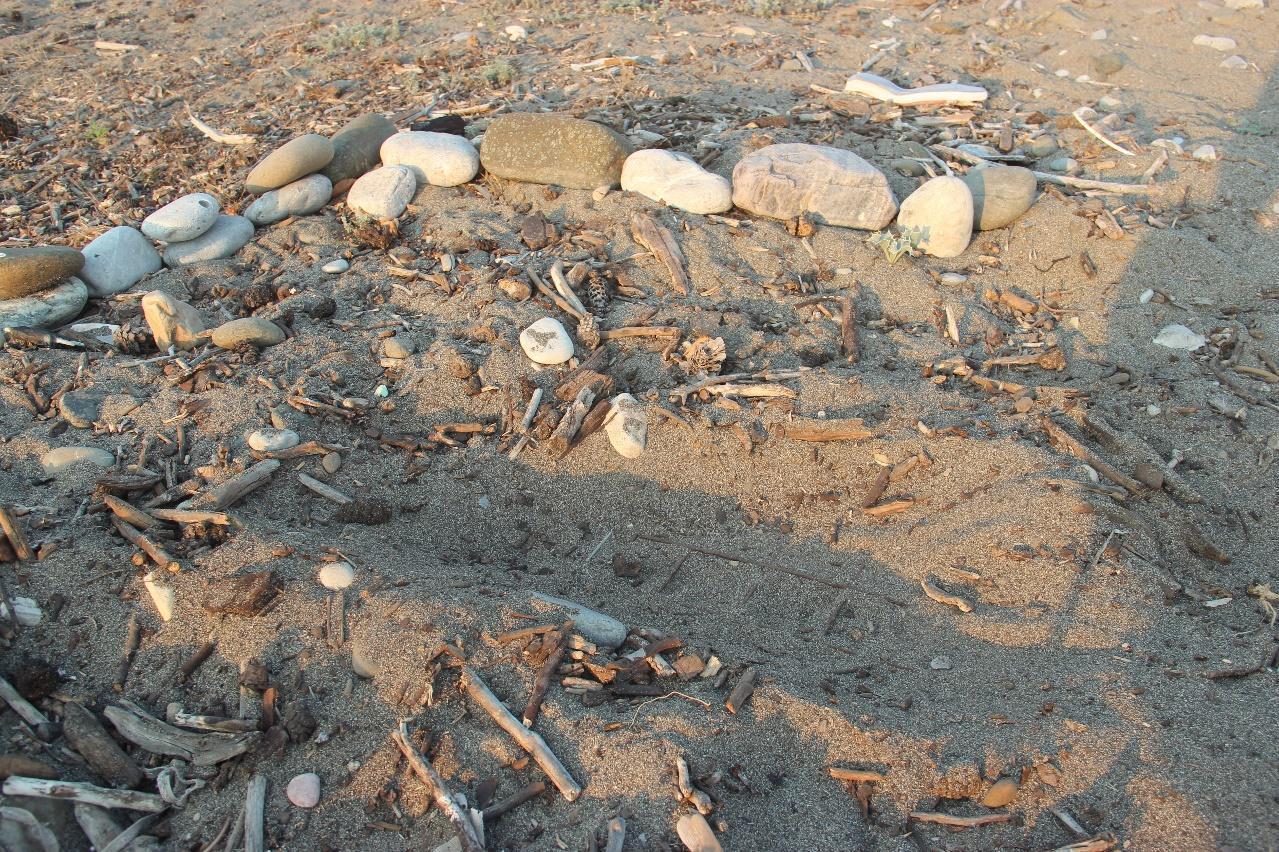
Fig.78. Fethiye SPA. Prism cages bearing different sea turtle signs and the nest number in a) Çalış B and b) Akgöl, hotspot. Note the plastic bag next to the cage in 78b.
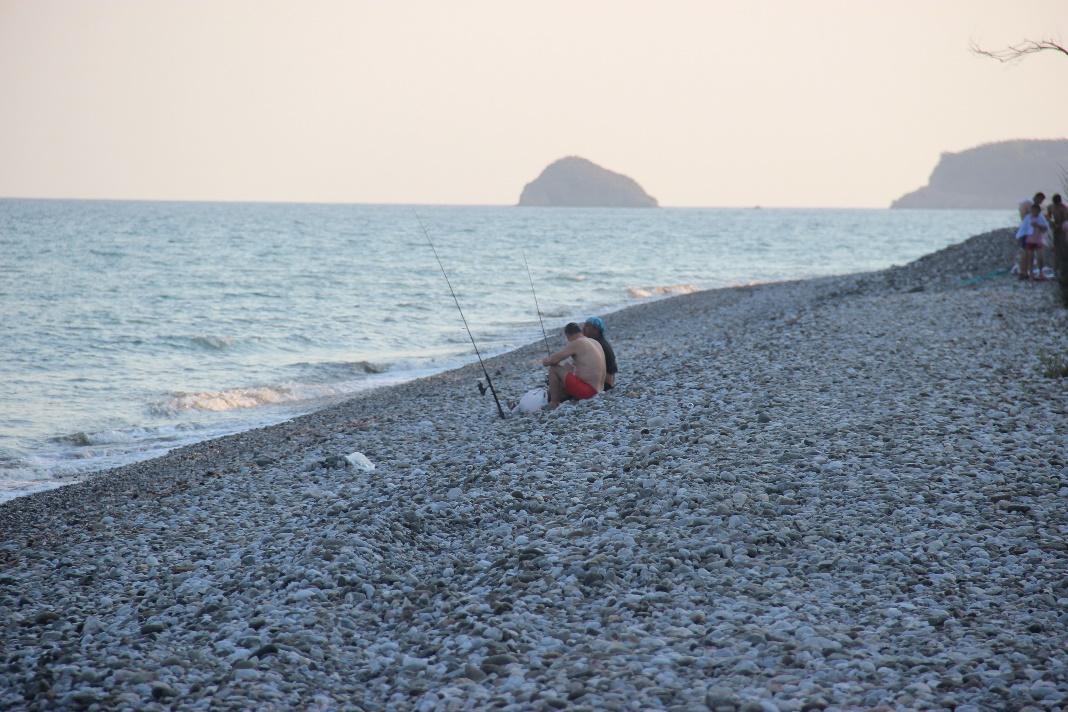

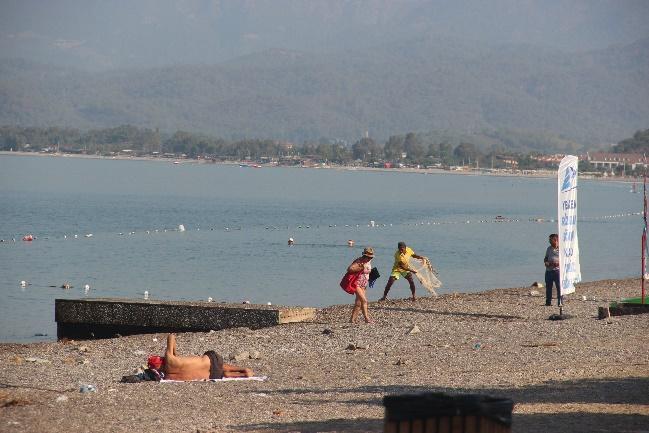


Fig.79.
Fig.80.


Fig.III. Fethiye SPA, Akgöl, Municipality's facility (Karaot Public Beach). Sunbeds, parasols, walkways and lifeguard tower covering the entire nesting zone which was development free before 2021. Around 200 were observed sunbeds in July 2022.

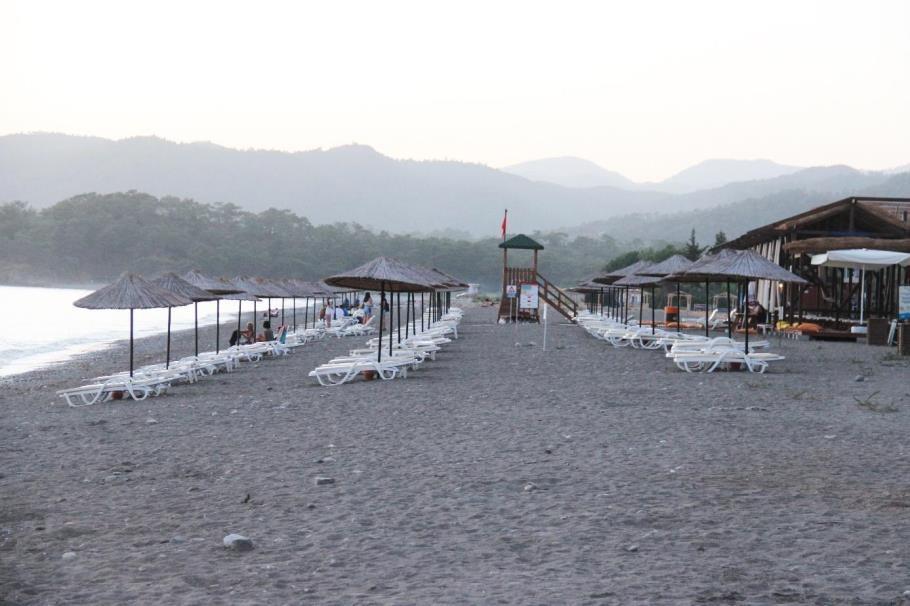
Canbolat,A.F. 2004. Areview ofsea turtlenestingactivityalongthe Mediterranean coast ofTurkey. Biol. Conserv. 116: 81 91
Bann C. & E. Başak. 2013. Economic Analysis of Fethiye Göcek Special Environmental Protection Area. GEF funded2009 13ProjectPIMS3697: StrengtheningtheSystemofMarine&Coastal ProtectedAreasofTurkey. Technical Report Series 11.
Başkale E., Y. Katılmış, M. Azmaz, D. Sözbilen, F. Polat, M. Lambropoulos, C. Fellhofer Mıhcıoğlu, M. Stachowitsch, Kaska, Y. 2016. Monitoring and Conservation of Loggerhead Turtle’s nests on Fethiye Beaches, Turkey. Biharean Biologist 10(1):20 23
Fellhofer Mihcioglu C., Rameder E., Lambropoulos M., Stachowitsch M., Atatunc K., Canbolat A.F. 2015. The westernmost Mediterranean record of a nesting green turtle, Chelonia mydas: Fethiye beach, Turkey, Aegean sea. In: Kaska, Y., Sonmez, B., Turkecan, O., Sezgin, C. (Eds). Book of abstracts of 35th Annual Symposium on Sea Turtle Biology and Conservation. MACARTpress, 250pp. Turkey.
Ilgaz, C., Türkozan, O., Özdemir, A., Kaska, Y. & M.Stachowitsch. 2007. Populationdecline ofloggerheadturtles: two potential scenarios for Fethiye beach, Turkey. Biodiversity and Conservation 16: 1027 1037.
Kaska, Y., Ilgaz, Ç., Özdemir, A., Baflkale, E., Türkozan, O., Baran, & M. Stachowitsch. 2006. Sex ratio estimations of loggerhead sea turtle hatchlings by histological examination and nest temperatures at Fethiye beach, Turkey. Naturwissenschaften, 93:338 343.
Katilmis, Y., Baskale, E., Polat, F., Azmaz M., & Y. Kaska. 2013. Decline of loggerhead turtle nests on Fethiye beach, Turkey. In: Tucker, T., Belskis, L., Panagopoulou, A., Rees, A., Frick, M., Williams, K., LeRoux, R., and Stewart, K. compilers. 2013. Proceedings of the Thirty Third Annual Symposium on Sea Turtle Biology and Conservation. NOAA Technical Memorandum NOAA NMFS SEFSC 645: 263 p
Margaritoulis, D., R. Argano, I. Baran, F. Bentivegna, M.N. Bradai, J.A. Camiñas, P. Casale, G. De Metrio, A. Demetropoulos, G. Gerosa, B.J. Godley, D.A. Haddoud, J. Houghton, L. Laurent & B. Lazar. 2003. Loggerhead turtles in the Mediterranean Sea: present knowledge and conservation perspectives. In: A. Bolten & B E. Witherington (Eds.). Loggerhead Sea Turtles. Smithsonian Books, Washington pp. 175 198. Oruç, A., Türkozan O. & H. Durmuş. 2003. In the Tracks of Marine Turtles: Assessment of Marine Turtle Nesting Sites 2003. WWF, Istanbul. 96pp. Türkozan, O. 2000. Reproductive ecology of the loggerhead turtle, Caretta caretta, on Fethiye and Kızılot beaches, Turkey. Chelonian Conservation and Biology 3:686 692.
Yılmaz, C. ,Türkozan, O., F. Bardakçı. 2008. Population genetic structure of loggerhead turtles, Caretta caretta, in Turkey based on mtDNA sequences, 3rd Mediterranean Conference on Marine Turtles.
Patara: REPORTS & COMPLAINT SUBMITTED TO THE BERN CONVENTION
Available online at www.medasset.org or www.coe.int
T PVS (96) 53. A.MEDASSET: Conservation of loggerhead turtles, Caretta caretta, and construction projects on the beach of Patara, Turkey.
T PVS (96) 53. MEDASSET: Conservation of loggerhead turtles, Caretta caretta, and construction projects on the beach of Patara, Turkey. (Brief Update on action to “Save Patara” 1989 1996).
T PVS (97) 45. MEDASSET: Marine turtle conservation in Patara, Turkey.
T PVS (98) 49. MEDASSET: Marine turtle conservation in Patara, Turkey.
T PVS (99) 69. MEDASSET: Caretta caretta in Patara, Turkey.
T PVS (2000) 57. MEDASSET: Conservation of the marine turtle, Caretta caretta, in Patara Turkey.
T PVS (2001) 72. MEDASSET Review of nature conservation situation in Patara SPA, Turkey.
T PVS/Files (2002) 14 MEDASSET. Update report and review of nature conservation measures in Patara SPA, Turkey.
T PVS/Files (2003) 12 MEDASSET. Update report and review of nature conservation measures in Patara SPA, Turkey.
T PVS/Files (2004) 13 MEDASSET. Update report and review of nature conservation measures in Patara SPA, Turkey.
T PVS/Files (2005) 09 MEDASSET. Update report and review of nature conservation measures in Patara SPA, Turkey.
(No T PVS reference) (2007) MEDASSET. Update report and review of nature conservation measures in Patara SPA, Turkey.
(No T PVS reference). (2009) MEDASSET. Update Report and review of nature conservation measures in Patara SPA, Turkey.
(No T PVS reference) Complaint (2012/9) MEDASSET. Complaint to the Bern Convention: construction of summer houses within Patara SPA, Turkey.
T PVS/Files (2013) 09 MEDASSET. Update on loggerhead sea turtle (Caretta caretta) conservation monitoring in Patara SPA, Turkey.
T PVS/Files (2014)16 MEDASSET. Update on loggerhead sea turtle (Caretta caretta) conservation monitoring in Patara SPA, Turkey.
T PVS/Files (2015) 34 MEDASSET. Update on loggerhead sea turtle (Caretta caretta) conservation monitoring in Patara SPA, Turkey.
T PVS/Files (2016) 35. MEDASSET Update on loggerhead sea turtle (Caretta caretta) conservation monitoring in Patara SPA, Turkey.
T PVS/Files (2017) 29 . MEDASSET Update on loggerhead sea turtle (Caretta caretta) conservation monitoring in Patara SPA, Turkey.
T PVS/Files (2018) 33. MEDASSET Update on loggerhead sea turtle (Caretta caretta) conservation monitoring in Patara SPA, Turkey.
T PVS/Files (2019). MEDASSET Update on loggerhead sea turtle (Caretta caretta) conservation monitoring in Patara SPA, Turkey.
2020 2022 Patara related reports submitted in combination with Fethiye, please see Fethiye list.
Fethiye: REPORTS & COMPLAINT SUBMITTED TO THE BERN CONVENTION
Available online at www.medasset.org or www.coe.int
T PVS/Files (2021) 62. Update Report. Loggerhead Sea Turtle (Caretta caretta) Conservation Monitoring in Fethiye and Patara SPAs, Turkey.
T PVS/Files (2020) 55. Update Report. Loggerhead Sea Turtle (Caretta caretta) Conservation Monitoring in Fethiye and Patara SPAs, Turkey.
T PVS/Files (2019) 28. Update Report. Loggerhead Sea Turtle (Caretta caretta) Conservation Monitoring in Fethiye and Patara SPAs, Turkey
T PVS/ Files (2018) 33 MEDASSET. August 2018. Update on Loggerhead sea turtle (Caretta caretta) Conservation Monitoring in Fethiye SPA, Turkey.
T PVS/Files (2017) 29 MEDASSET. August 2017. Update on Loggerhead sea turtle (Caretta caretta) Conservation Monitoring in Fethiye SPA, Turkey.
T PVS/Files (2016) 35 MEDASSET. October 2016. Update on Loggerhead sea turtle (Caretta caretta) Conservation Monitoring in Fethiye SPA, Turkey.
T PVS/Files (2015) 34 MEDASSET. September 2015 Update on Loggerhead sea turtle (Caretta caretta) Conservation Monitoring in Fethiye SPA, Turkey.
T PVS/Files (2014) 16. MEDASSET. March & August 2014. Update on Loggerhead sea turtle (Caretta caretta) Conservation Monitoring in Fethiye SPA, Turkey.
T PVS/Files (2014) 16. MEDASSET. March & August 2014. Update on Loggerhead sea turtle (Caretta caretta) Conservation Monitoring in Fethiye SPA, Turkey.
T PVS/Files (2013) 9. MEDASSET. March & September 2013. Update on Loggerhead sea turtle (Caretta caretta) Conservation Monitoring in Fethiye, Turkey.
T PVS/Files (2012) 42. MEDASSET. September 2012. Update on Loggerhead sea turtle (Caretta caretta) Conservation Monitoring in Fethiye, Turkey.
(No T PVS reference). MEDASSET. December 2011. Update on Loggerhead sea turtle (Caretta caretta) Conservation Monitoring in Fethiye, Turkey.
(No T PVS reference). MEDASSET. April 2011. Destruction of Sea Turtle Nesting Beaches in Fethiye SPA, Turkey.
(No T PVS reference). MEDASSET. March 2011. Update on Loggerhead sea turtle (Caretta caretta) Conservation Monitoring in Fethiye, Turkey.
T PVS (2010) 08 E. MEDASSET. March & September 2010. Implementation of Recommendation No. 66 (1998) on the conservation status of some nesting beaches for marine turtles in Turkey. (No T PVS reference). MEDASSET. Sept 2009. Complaint to Bern Convention addressing the threats facing the loggerhead sea turtle (Caretta caretta) nesting beaches in Fethiye, Muğla province, Turkey. (No T PVS reference). MEDASSET. September 2008. Sea turtle nesting beach degradation in Çirali and Fethiye, Turkey.
Recommendation No 8 (1987) on the protection of marine turtles and their habitat
Recommendation No. 12 (1988) ) concerning the protection of important turtle nesting beaches in Turkey
Recommendation No. 24 (1991) on the protection of some beaches in Turkey of particular importance to marine turtles
Recommendation No. 54 (1996) on the conservation of Caretta caretta at Patara
Recommendation No. 66 (1998) on the conservation status of some nesting beaches for marine turtles in Turkey
Recommendation No. 182 (2015) on the conservation of Caretta caretta and its habitat at Patara (Turkey)
Recommendation No. 183 (2015) on the conservation, management, and restoration of Fethiye nesting beaches (Turkey)
Report prepared by MEDASSET the Mediterranean Association to Save the Sea Turtles
for the Spring Bureau Meeting of 2022 the Contracting Parties to the Convention on the Conservation of European Wildlife and Natural Habitats (Bern Convention)
MEDASSET hereby submits an updated report to the Spring Bureau Meeting of the Bern Convention (April 2022) on the presumed degradation of nesting beaches in Fethiye and Patara SPAs in Turkey.
Contents:
Following our previous report for the 41sth Standing Committee Meeting of the Contracting Parties to the Convention on the Conservation of European Wildlife and Natural Habitats (Bern Convention) there has been no positive progress on the status of the nesting beaches in Fethiye and Patara SPAs. The following presents our update report in relation toeach of the measures under Recommendation No. 183 and 182 (2015).
Fethiye Specially ProtectedArea: Recommendation No. 183 (2015)
The loggerhead sea turtle (Caretta caretta) nesting beaches in Fethiye (Mugla Province, Turkey) are among the 12 most important nesting beaches in Turkey. The nesting beaches belong to the Fethiye Göcek Special Environmental Protection Area (SPA) established in 1988. Scientific studies have shown that nest numbers in Fethiye are declining.
There have been no improvements since our last report and the situation remains unchanged. The habitat destruction continues, as the new businesses and hotels constructed directly on or behind the nesting beaches and expanded onto the nesting zone still stand and further reduce the available habitat for the sea turtles.
Furthermore on March 6, 2022, newspapers published articles that the Ministry of Environment, Urbanization and Climate Change (that is the new name now) is planning to re assign/zone SPA's for construction permit, mainly for energy investments, before the elections next year.
https://www.cumhuriyet.com.tr/turkiye/zeytinliklerden sonra sit alanlari da ranta aciliyor 1913349
The Ministry refuted this information: https://csb.gov.tr/korunan alanlarin tespitine iliskin yonetmelik degisikligi resmi gazetede bakanlik faaliyetleri 32059. However, there are reports that unlicensed construction attempts have already started in some parts of Fethiye: https://www.sozcu.com.tr/2022/gundem/yeni imar barisi soylentisi fethiyede kacak yapi furyasi baslatti 6996877
Although the locations mentioned in the news piece are not nesting beaches, this is definitely of concern and we shall report on this upon our onsite inspection.
On another subject, the section directors of the Ministry, along with the Municipality, had a meeting with tourism facilities in January, on the Ministry's new projects in Fethiye, on how to protect sea turtle nesting habitats: https://www.facebook.com/calisplajifethiye/posts/328698775923443. Since we do not yet have
information on these “new projects”, we reserve our position and shall inform the Bureau of the Bern Convention in our next report.
We have also reports that the new promenade area in Fethiye/Calis seems to be entirely finished now: https://www.facebook.com/photo/?fbid=348546190605368&set=pcb.348546330605354.
In addition, concerned citizens shared photos showing new wooden posts on Çalış Beach, https://www.facebook.com/photo.php?fbid=1106500696809005&set=p.1106500696809005&type=3, the purpose of which are unknown.
As we reported in the summer of 2021, at least three previously undeveloped nesting beach sections were occupied by new businesses and newly constructed hotels, despite Recommendation No. 183 (2015) urging against further coastal building(Rec. Point 1, 6).Wecontinueto refutethe 2021 Government Report that “90% of the businesses, hotels or houses on the coastline were built before 1988”, as roads and buildings have been constructed on the beach since 2009 onwards, as demonstrated by MEDASSET’s annual reports. There has been no structure removal of any form or restoration of the nesting beaches (Rec. Point 2). We cannot report on the status of beach furniture on the nesting beaches, which as we observed last summer are not removed at night (Rec. Point 5), as this is the tourism off season.
The same applies for our findings regarding improvements in management and enforcement which had identified lack of beach furniture management, no zoning of the beach or marine area, inadequate signage, camping, bonfires, planting on the nesting beaches, severe light pollution, lack of vehicle access control, and human presence at night (Rec. Points 2, 4 8, 11, 15).
We have no updates on any indications of new conservation and management efforts required under Recommendation No. 183 (2015) to address these problems (Rec. Points 13, 14). We had reported on certain improvements, such as the absence of playgrounds, reduced number of volleyball courts; reduced amount of litter (Rec. Point 12); irregular beach furniture management and walkway removal in just 1.5 km of the 8 km nesting beaches; minor efforts to reduce light pollution through street light adjustments and red/orange light use in a few businesses. We also expect that nest monitoring and awareness activities by research institutions will continue in during 2022, however we are concerned as to whether there will be improvements to their inadequate financial and human resources (Rec. Point 10, 16).
Seven years since the adoption of Recommendation No. 183 (2015) the vast majority of the prescribed measures have not been implemented. The nesting beaches in Fethiye Specially Protected Area (SPA) remain unmanaged and inadequately protected. It is highly questionable whether the coastal zone of Fethiye can be considered a “protected” area based on its current status and the destructive development that has been permitted to occur over the past years in complete disregard of the Bern Convention’s Recommendation.
The key unresolved conservation problems that are negatively impacting the nesting beaches remain: As we reportedlast summer there wasa complete lackof zoning, insufficient information signs,lackof vehicle access control, horseridingand camping(Rec. Points 2and 9).Additionally, thereis verypoor beach furniture management at the SPA’s single beach facility which covers approx. 200 m of the 12 km beach but is located within the nesting hotspot (Rec. Point 2). A few sources of direct light pollution remain, that can be easily tackled, though skyglow impacts from the summer house village need to be monitored (Rec. Point 2). Of extreme concern was the reported illegal sand extraction: systematic and ongoing control and surveillance is needed across the SPA. There was no local management staff present (rangers, guards) and any policing observed did not resolve the above conservation problems Rec. Point 3). In addition, there seemed to be a lack of resources that lead to insufficient nest monitoring and protection from trampling or predation (Rec. Point 4, 7, 8).
We reported that SPA management and regulation enforcement is lacking, while construction of the approximately 300 summerhouse development in the 3rd DegreeArchaeological site of the SPAcontinues, in proximity to the dunes and the nesting beach (Rec. Point 4). We had reported on the redetermination of Patara SPA’s borders and zoning (Rec. Point 1), and, as no final maps are available online, it is unclear if the entire nesting beach (north and south section), the nearshore marine areas and the entire sand dune areas are appropriately zoned and protected against any further development.
To date, Recommendation No. 182 (2015) has not been fully implemented. It is a fact that Patara’s nesting beaches have been relatively safeguarded against development to date. We continue to believe that with increased management and control for effective implementation of the Recommendation, this unique natural and heritage site could become a showcase example, similar to the much renowned nearby Dalyan SPA (İztuzu beach). It is of high priority for authorities to take action and resolve the remaining unresolved conservation and management problems with no further delay, in light of the renewed interest in the SPA’s archaeological site.
MEDASSET anxiously awaits the response of the Turkish government to the Bern convention requests that the next Government report include an action plan for implementation of all points of the Recommendations before the nesting season, including Management plans and details on zoning at both sites. Our concerns are heightened following the news published on March 6, 2022, that the Ministry of Environment, Urbanization and Climate Change is planning to re assign/zone SPA's, which include Patara, for construction permit, mainly for energy investments.